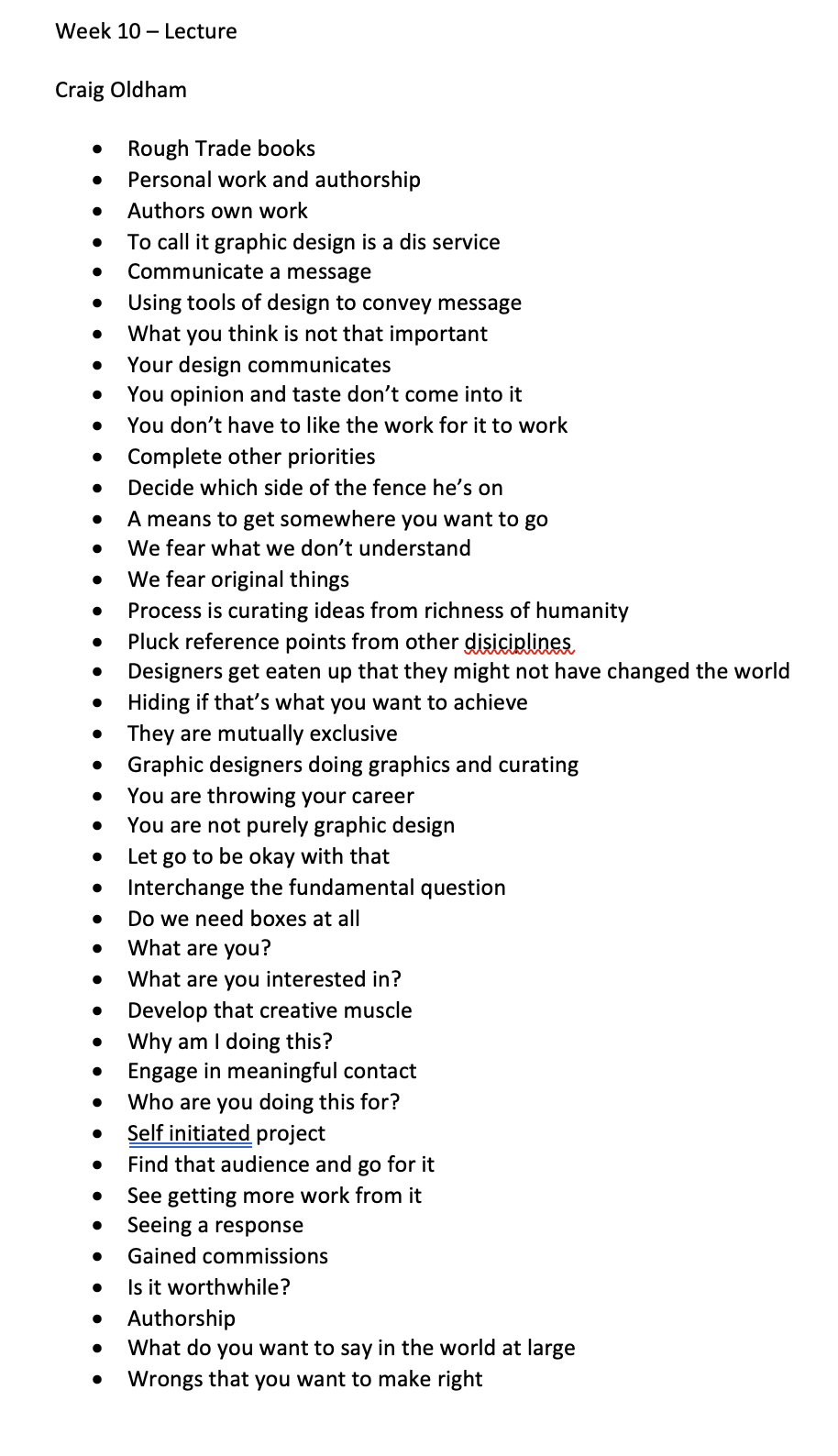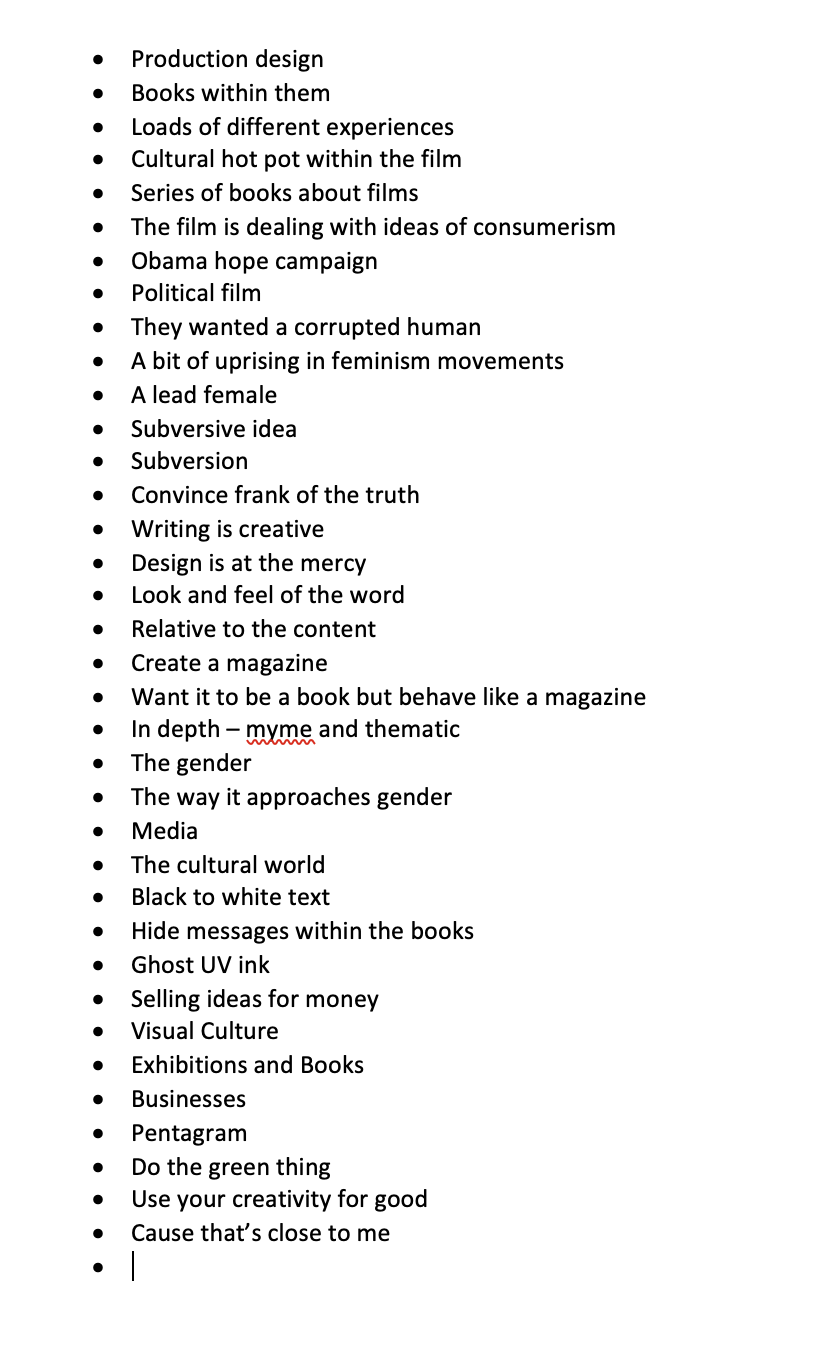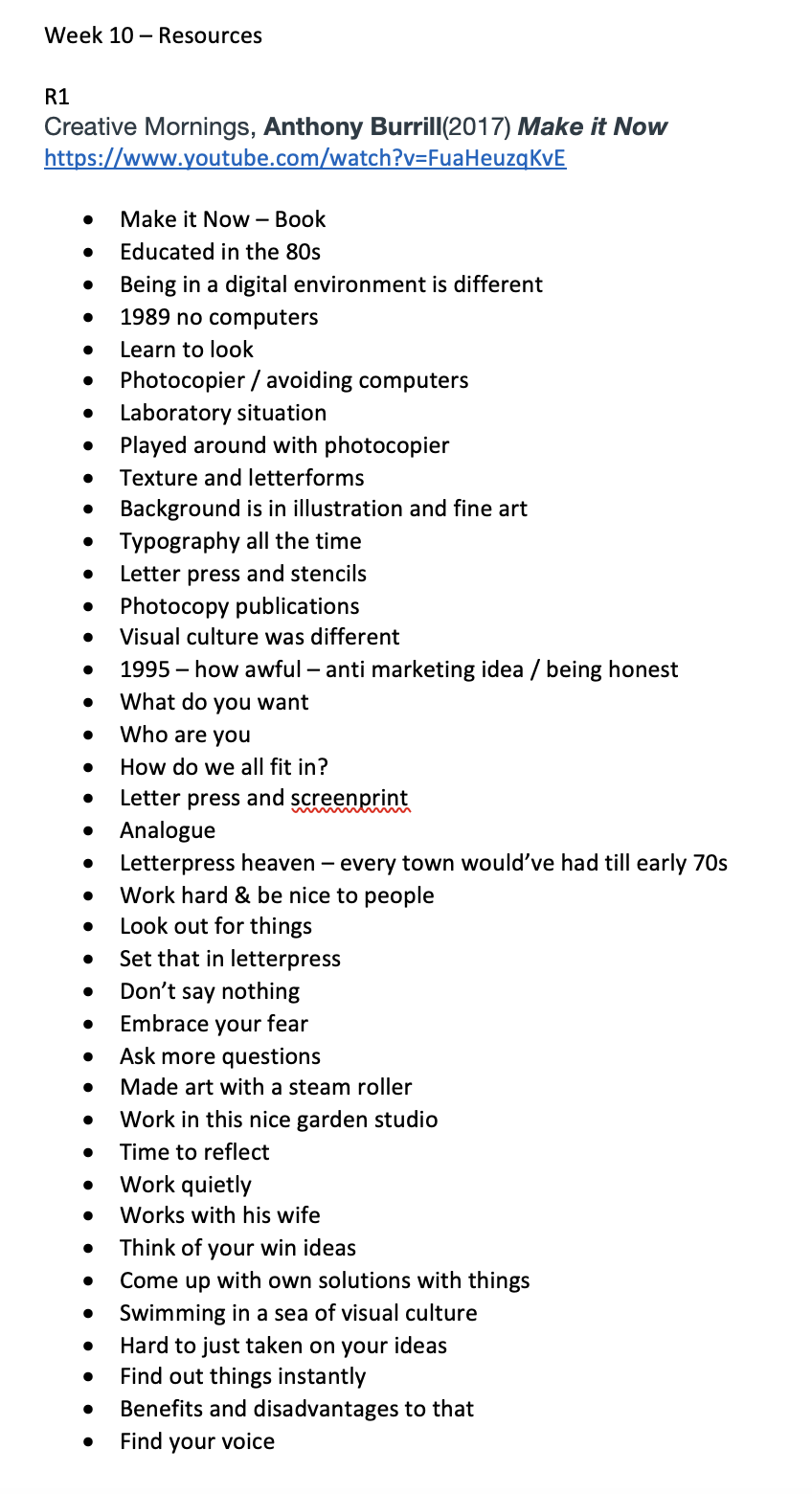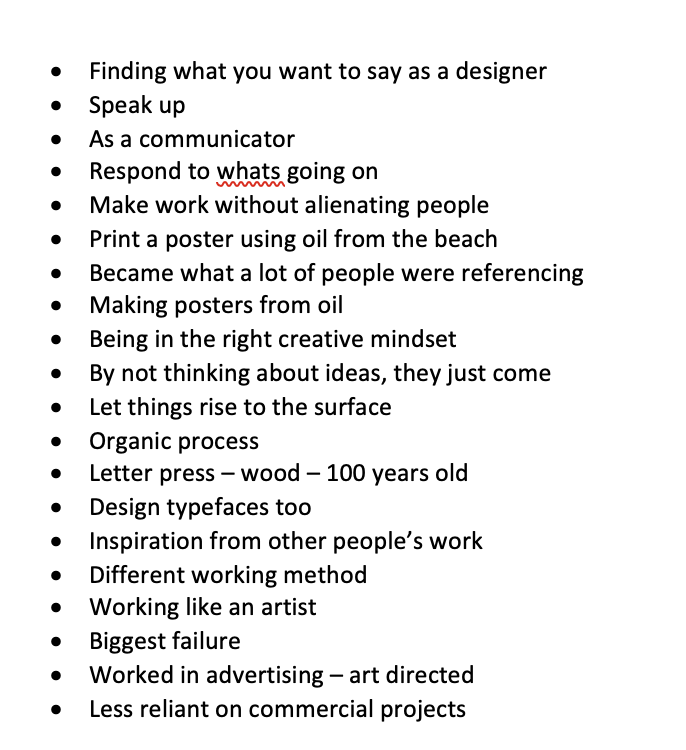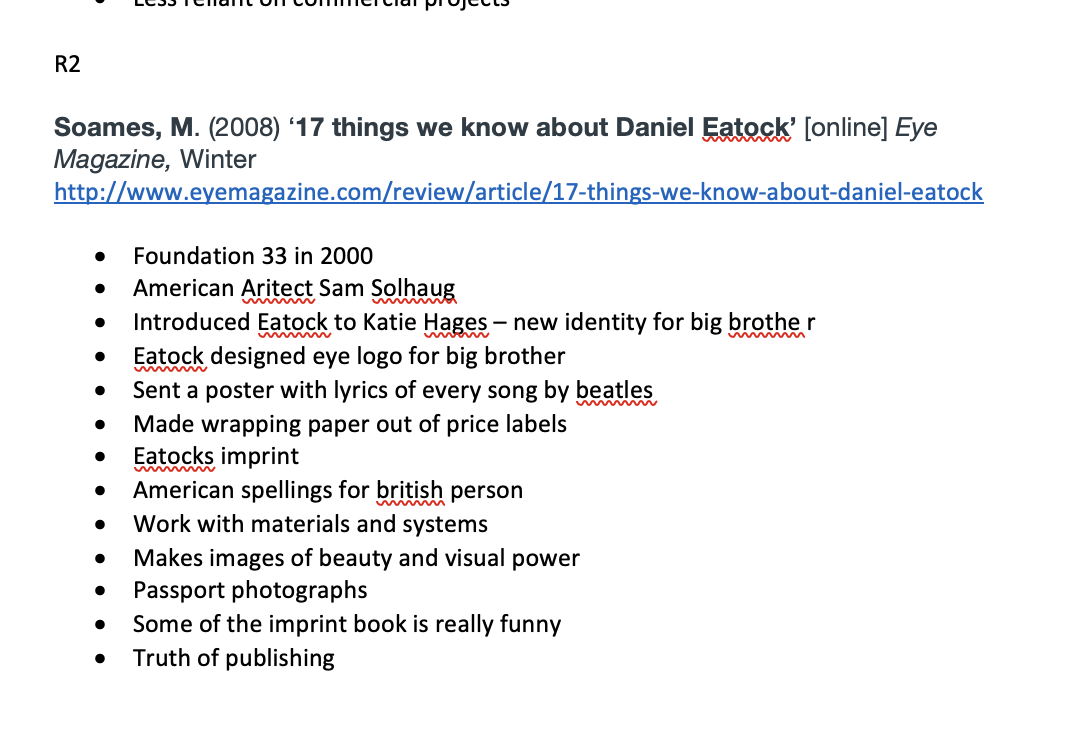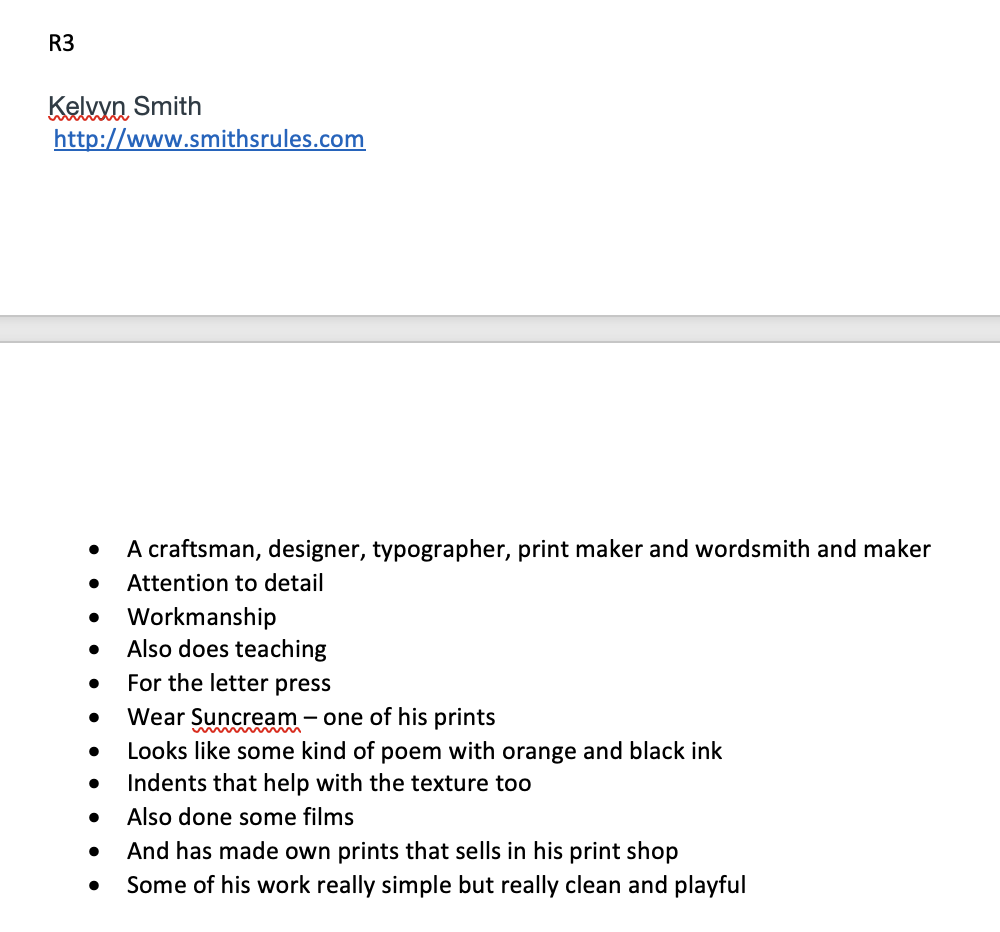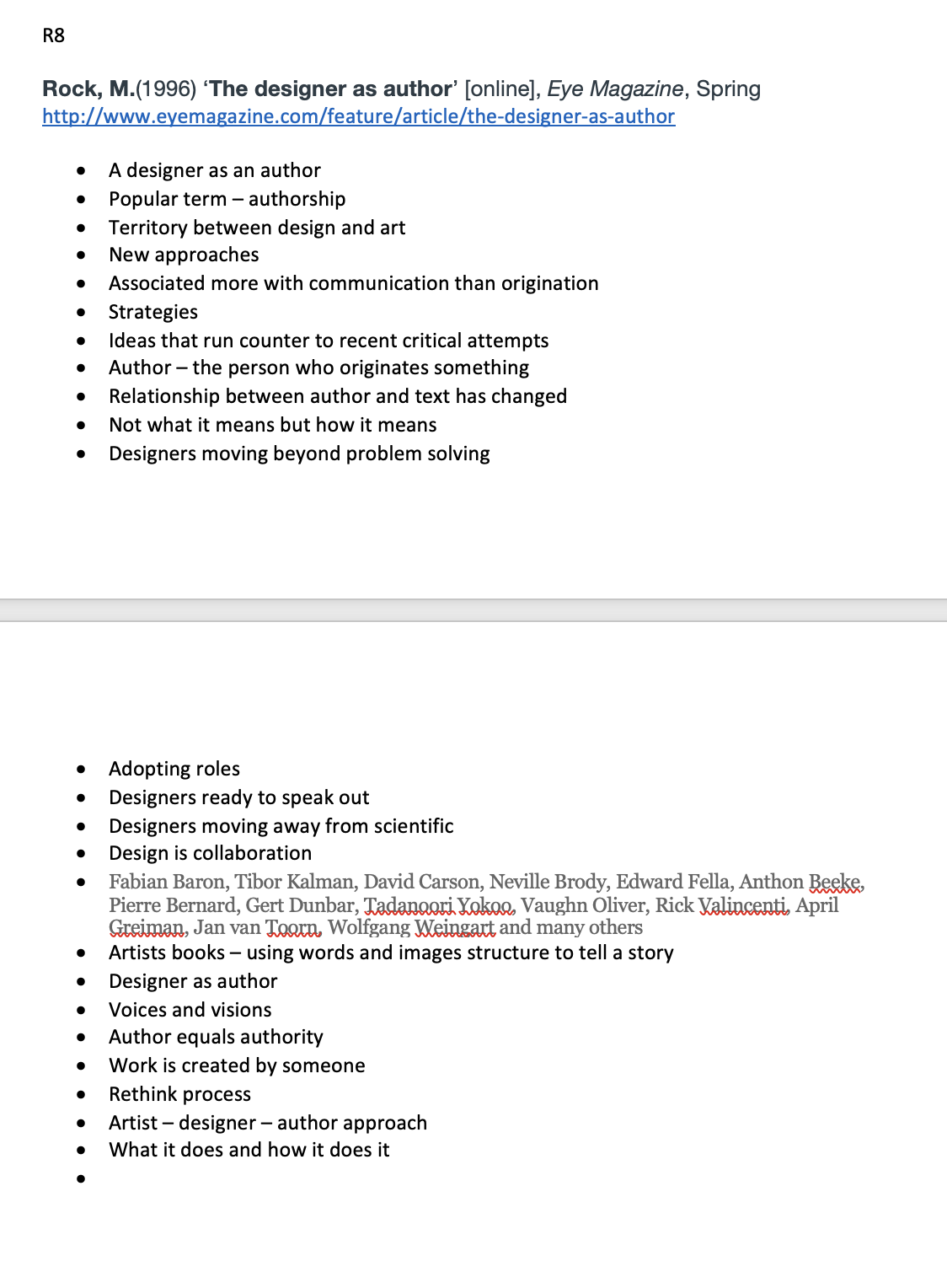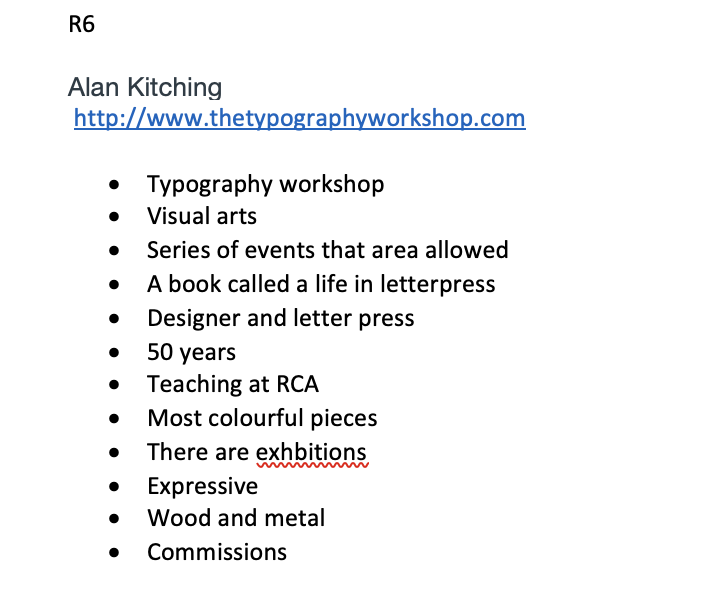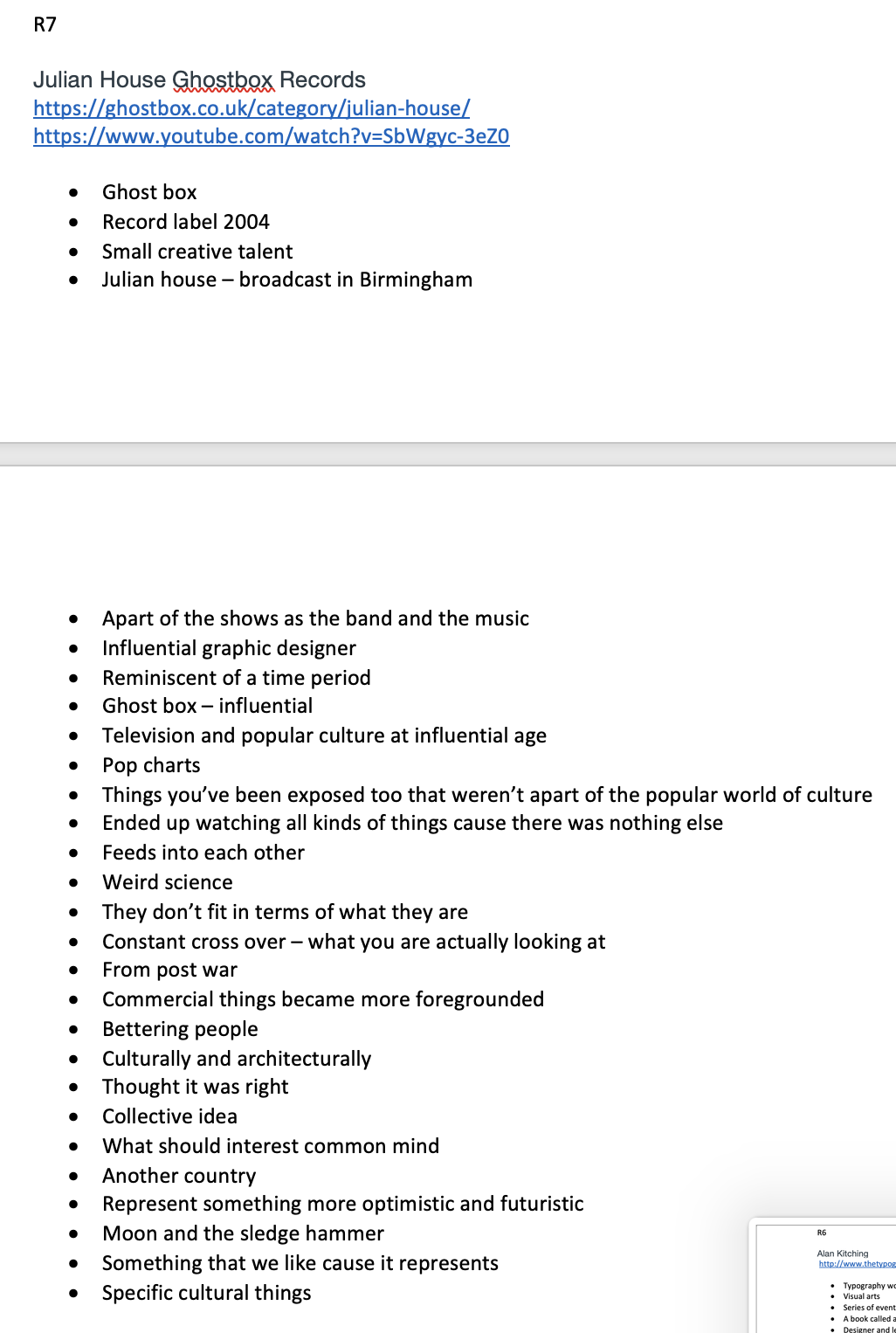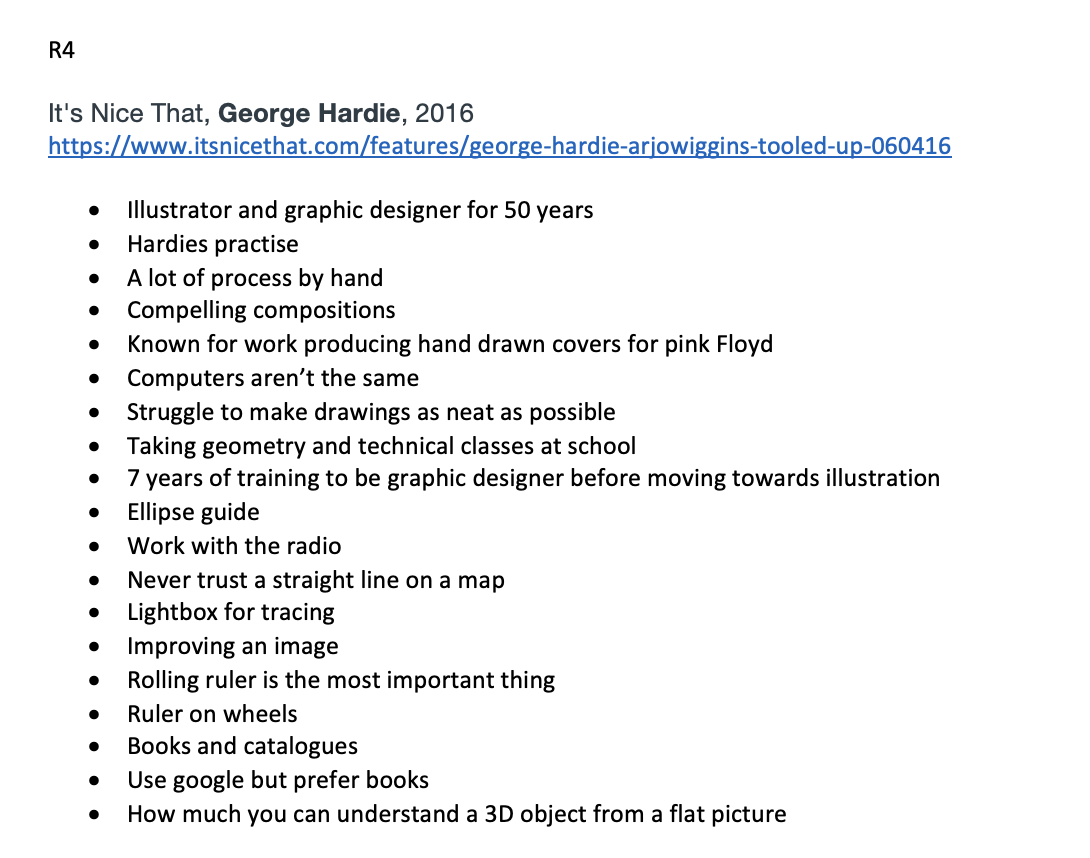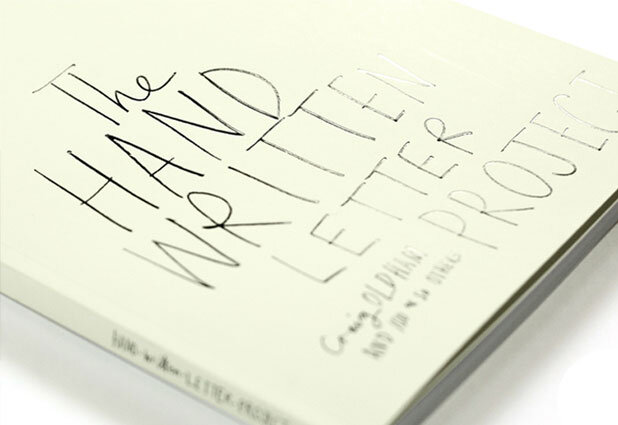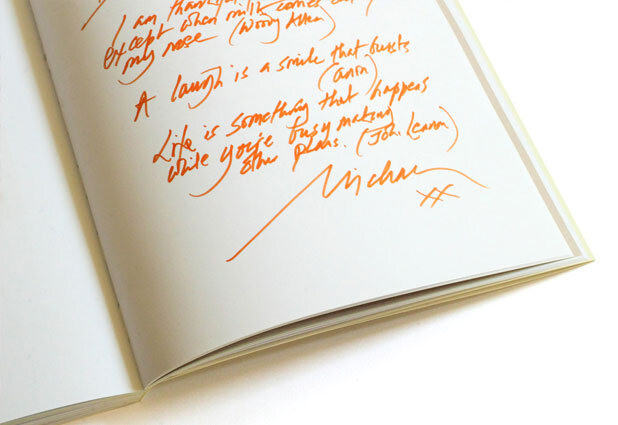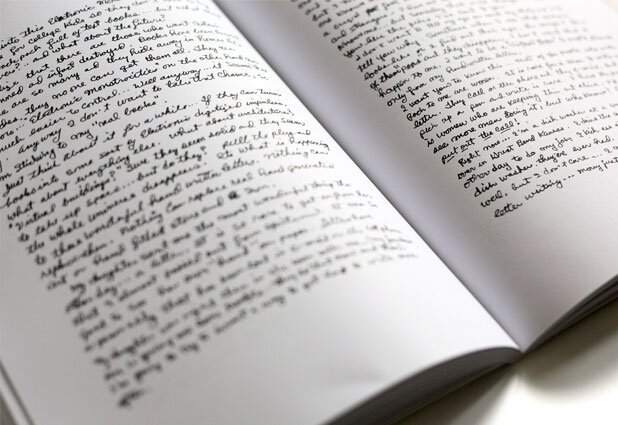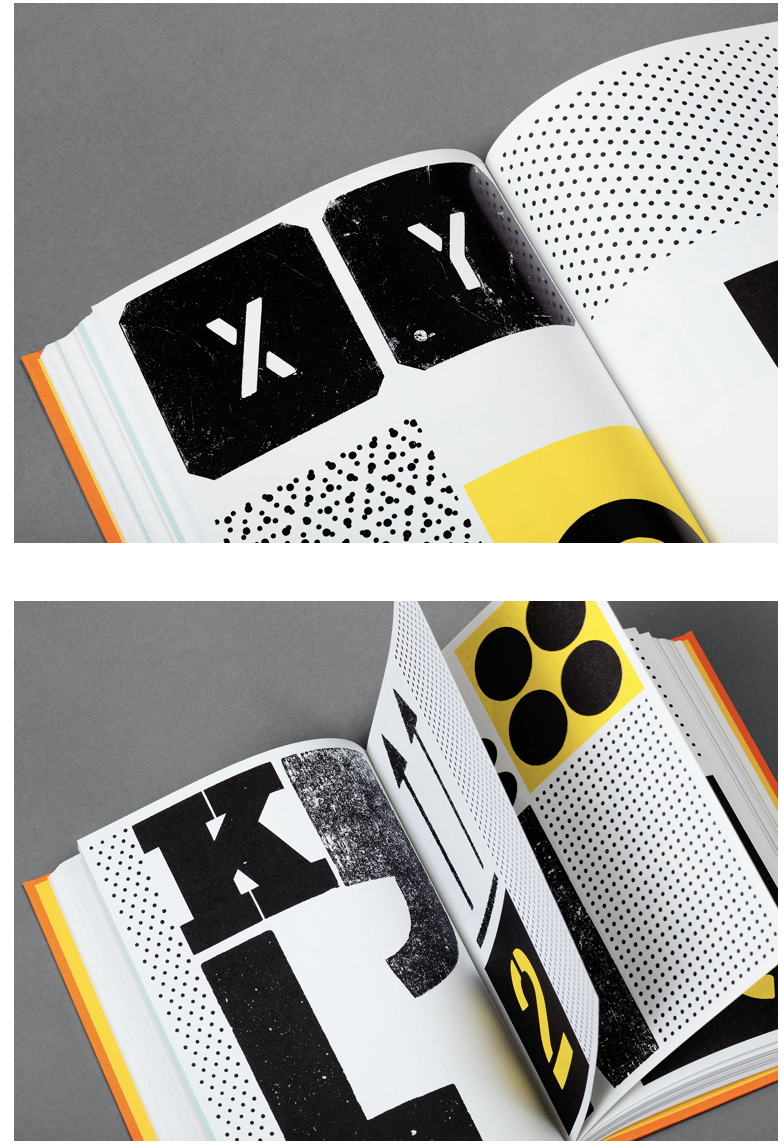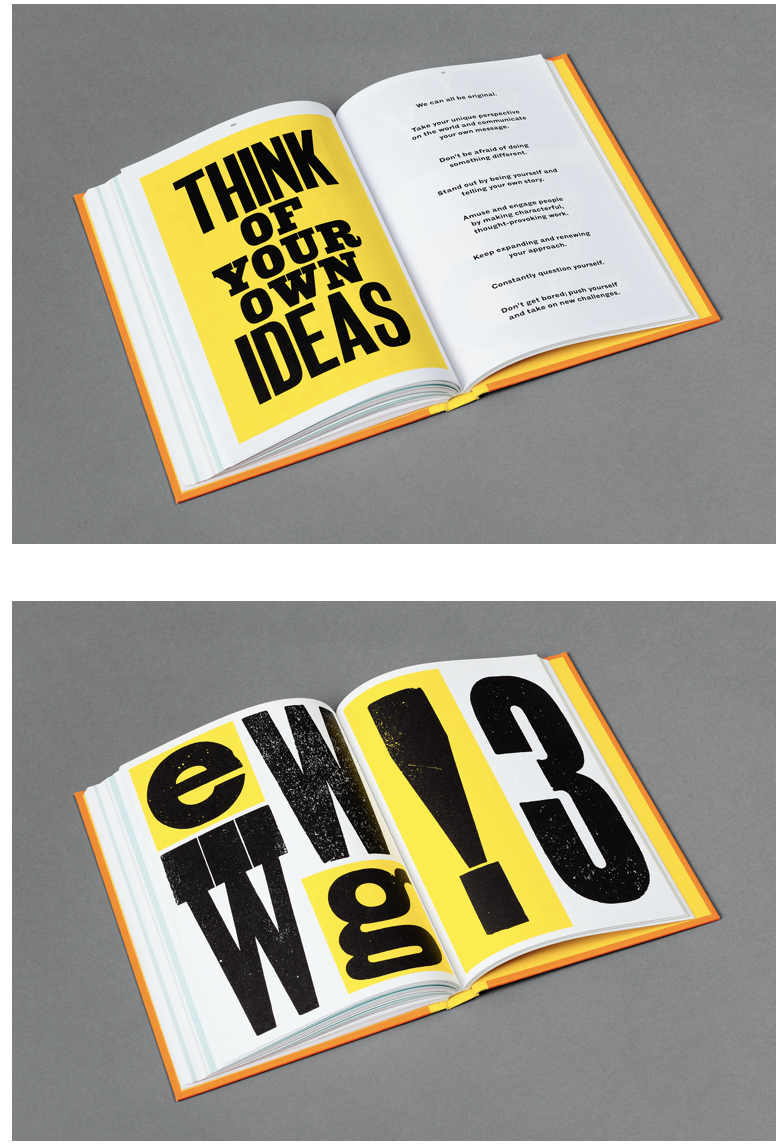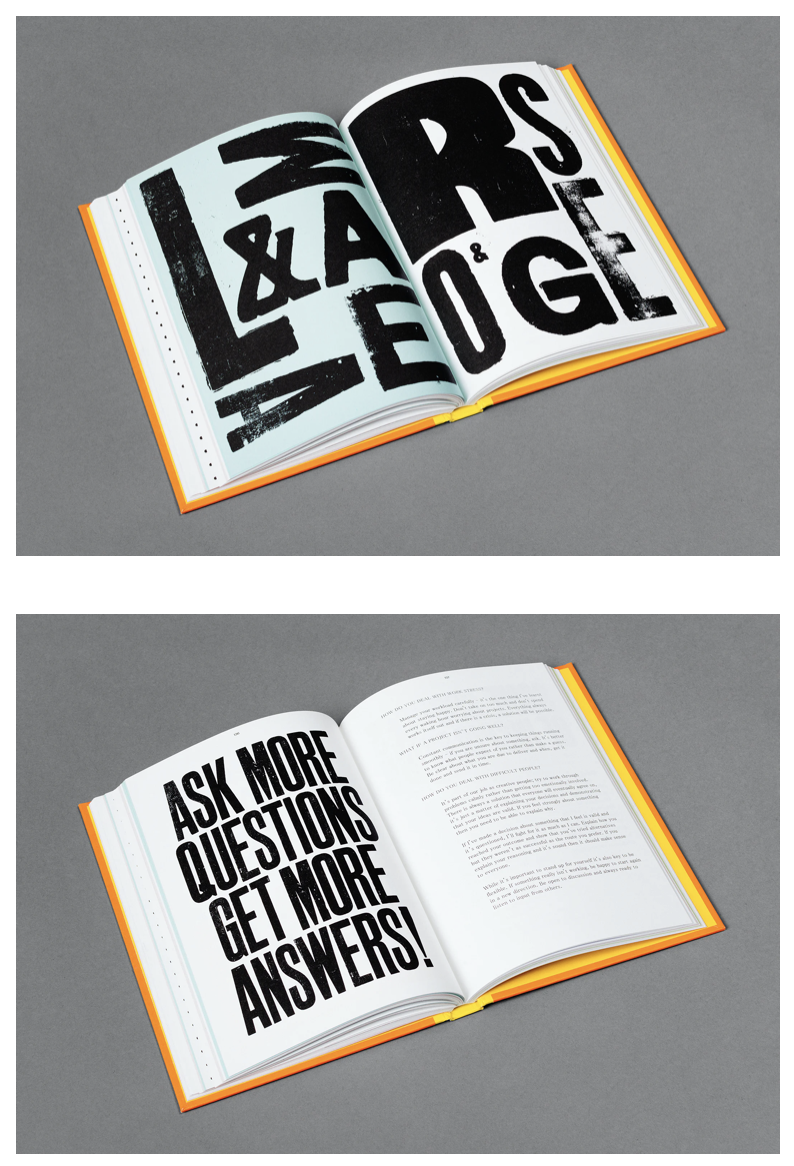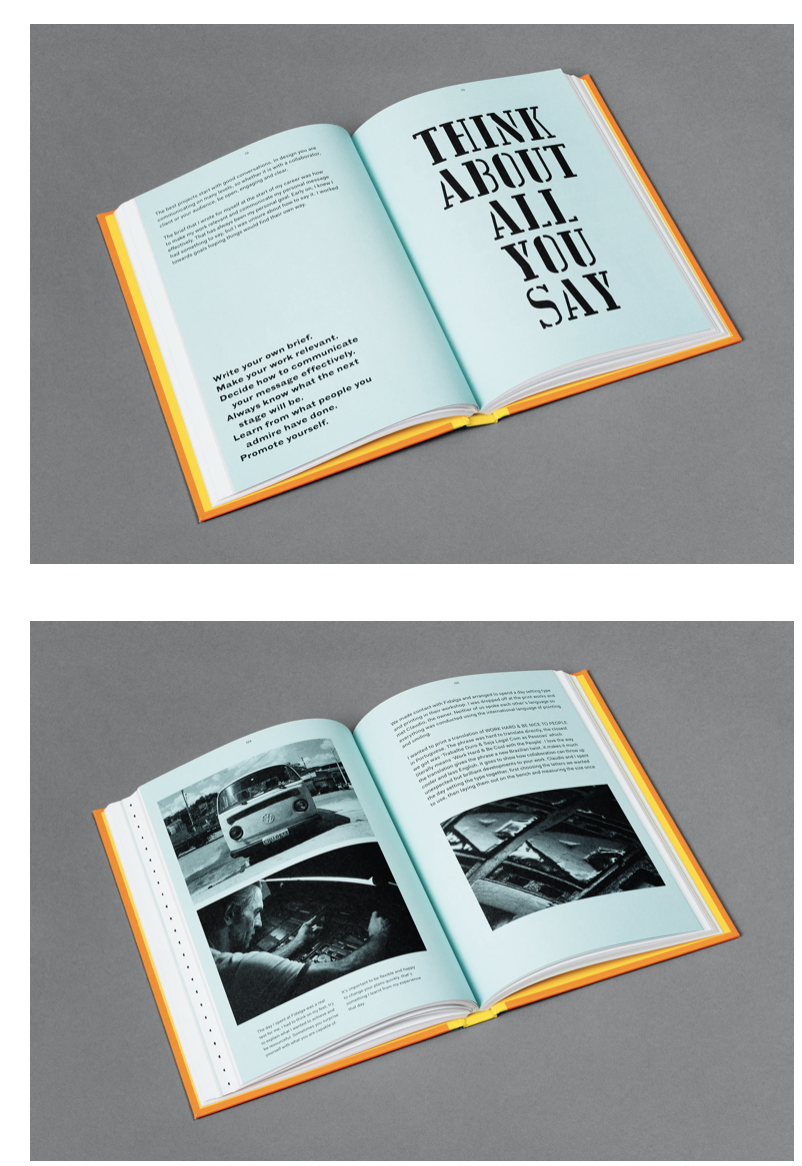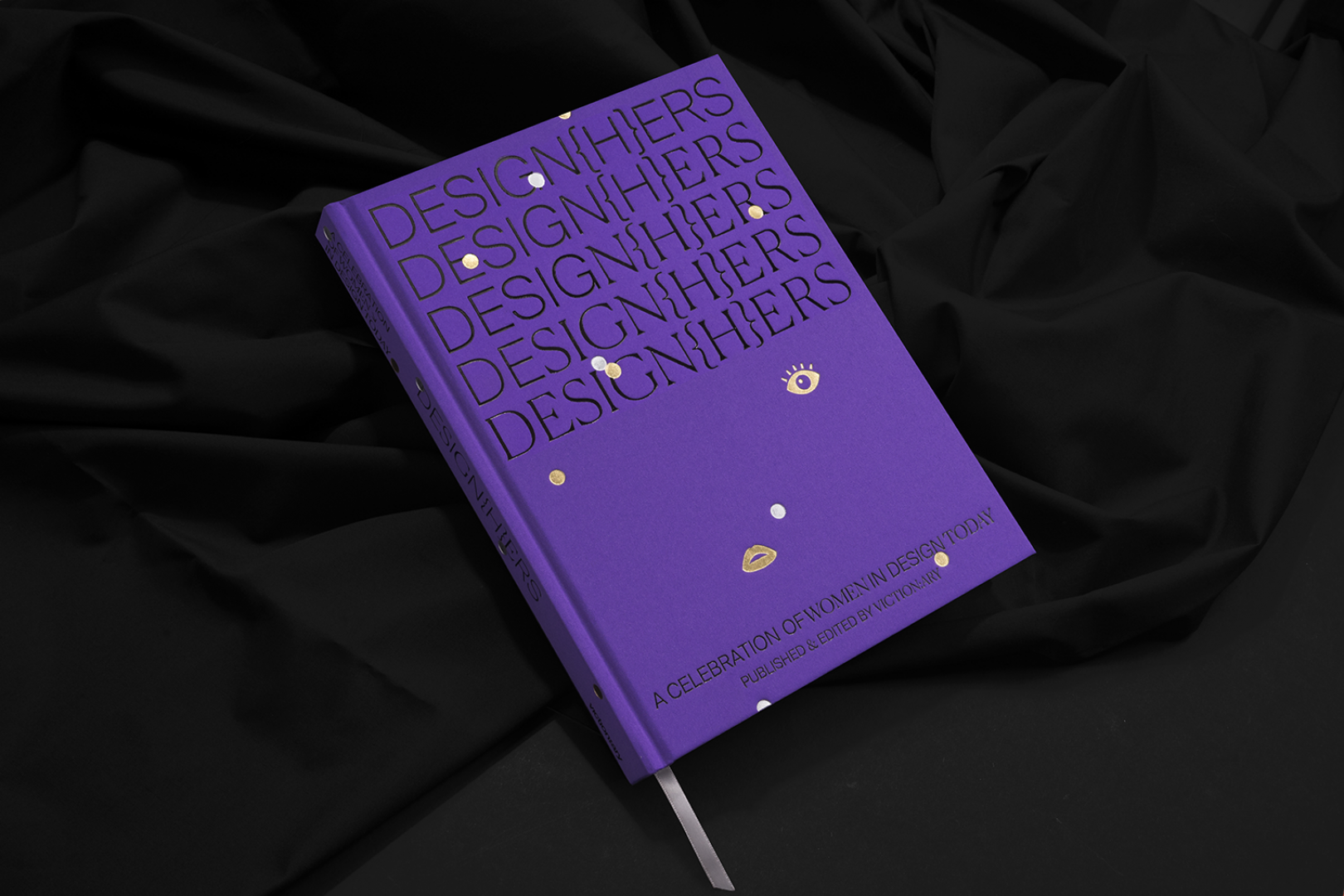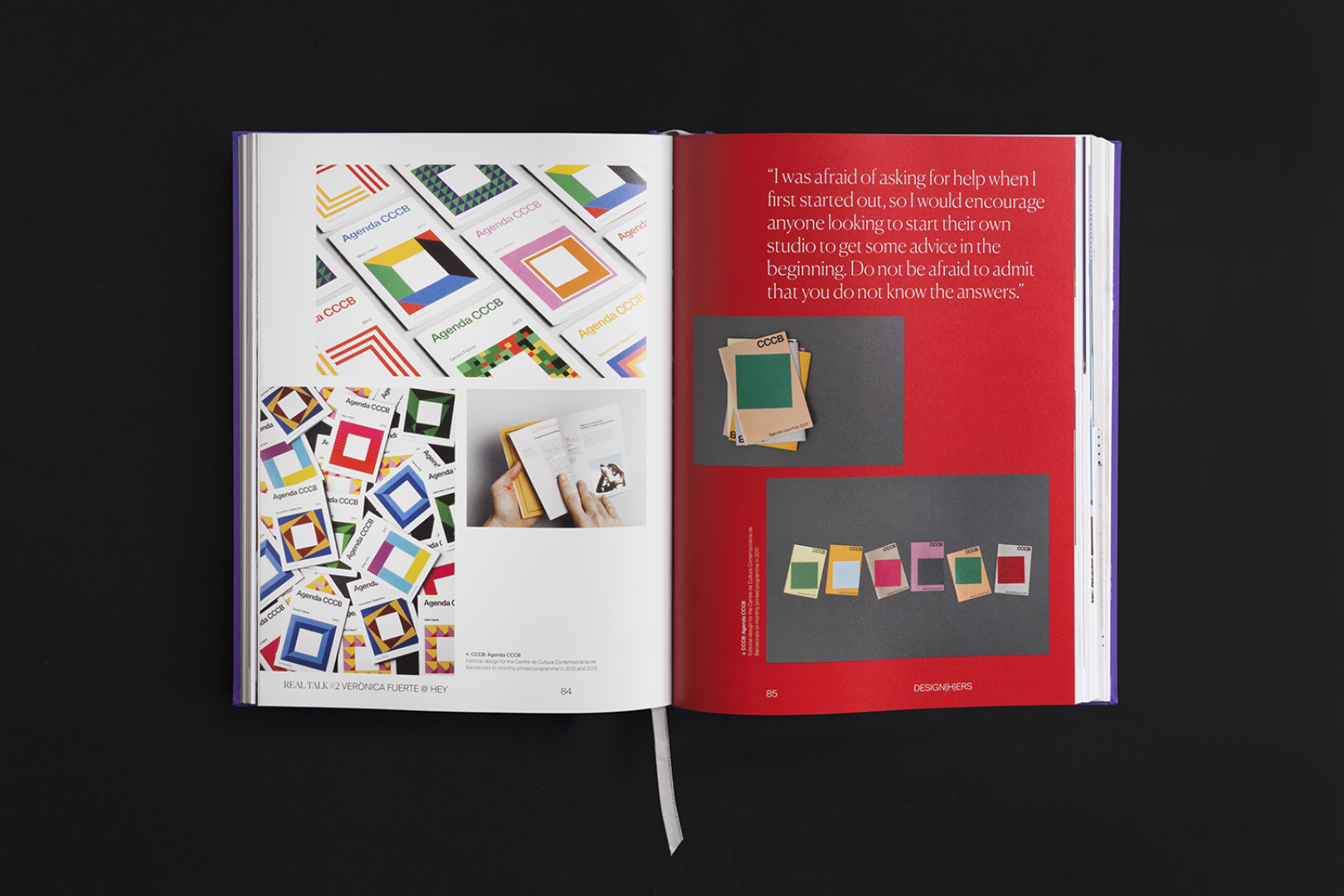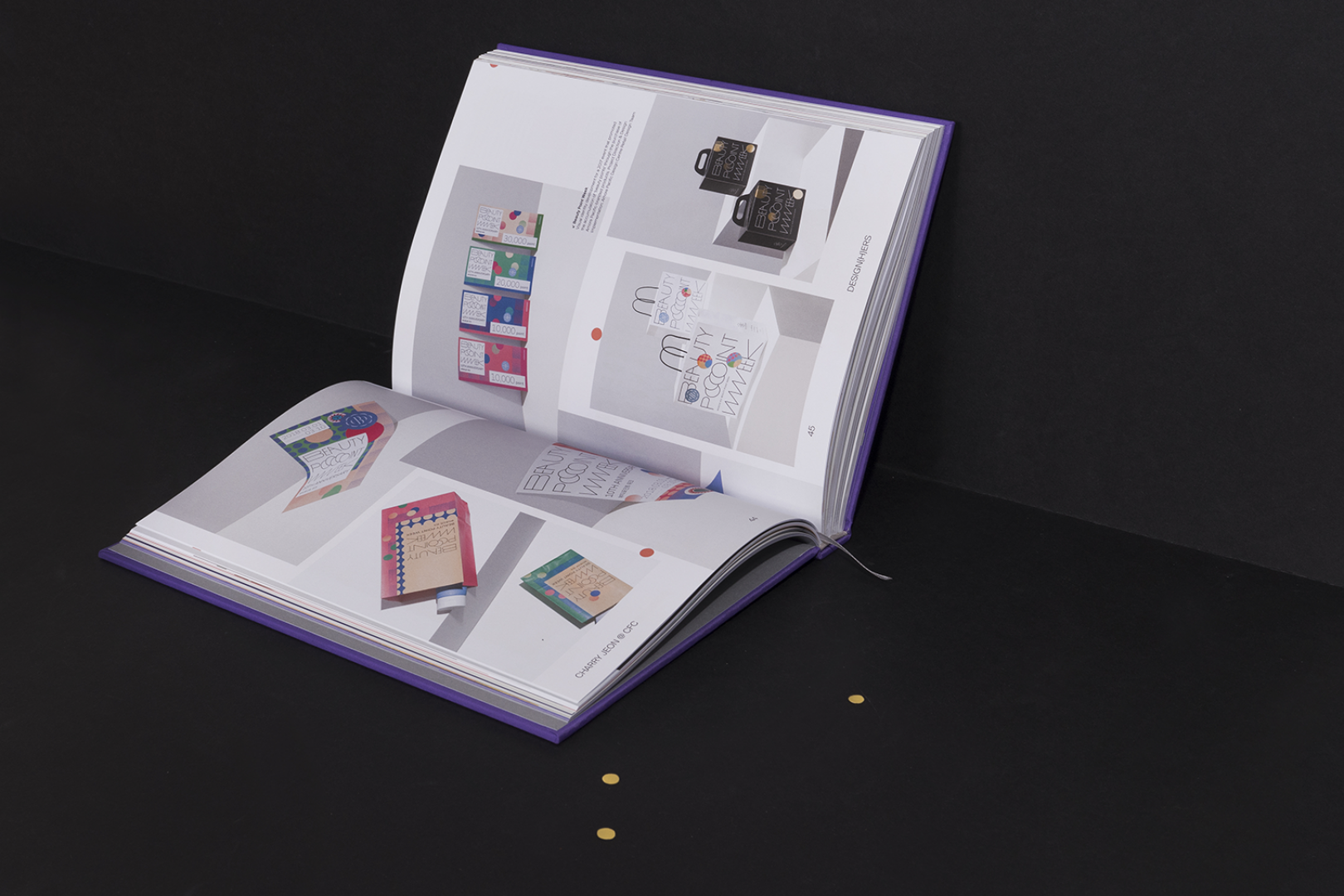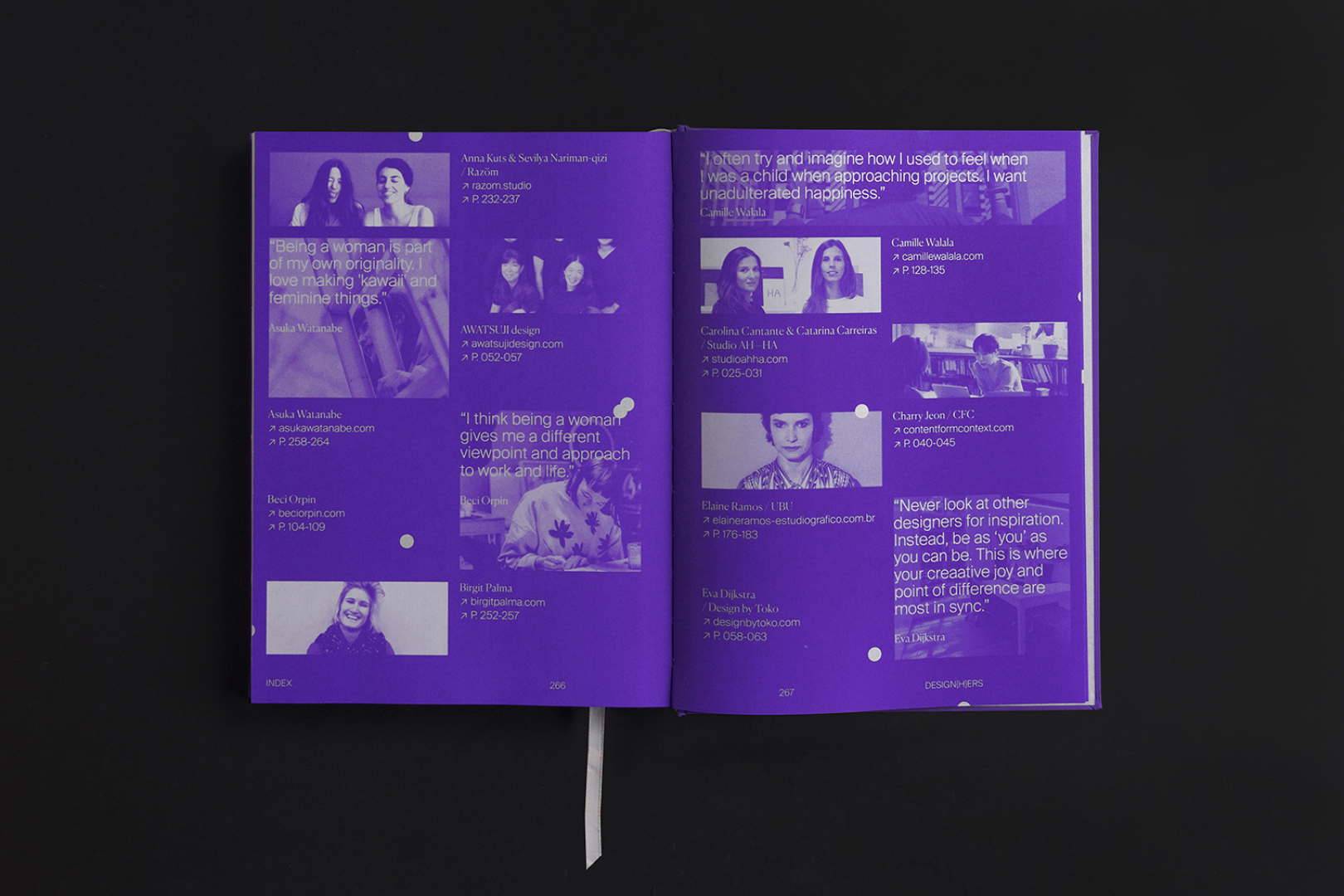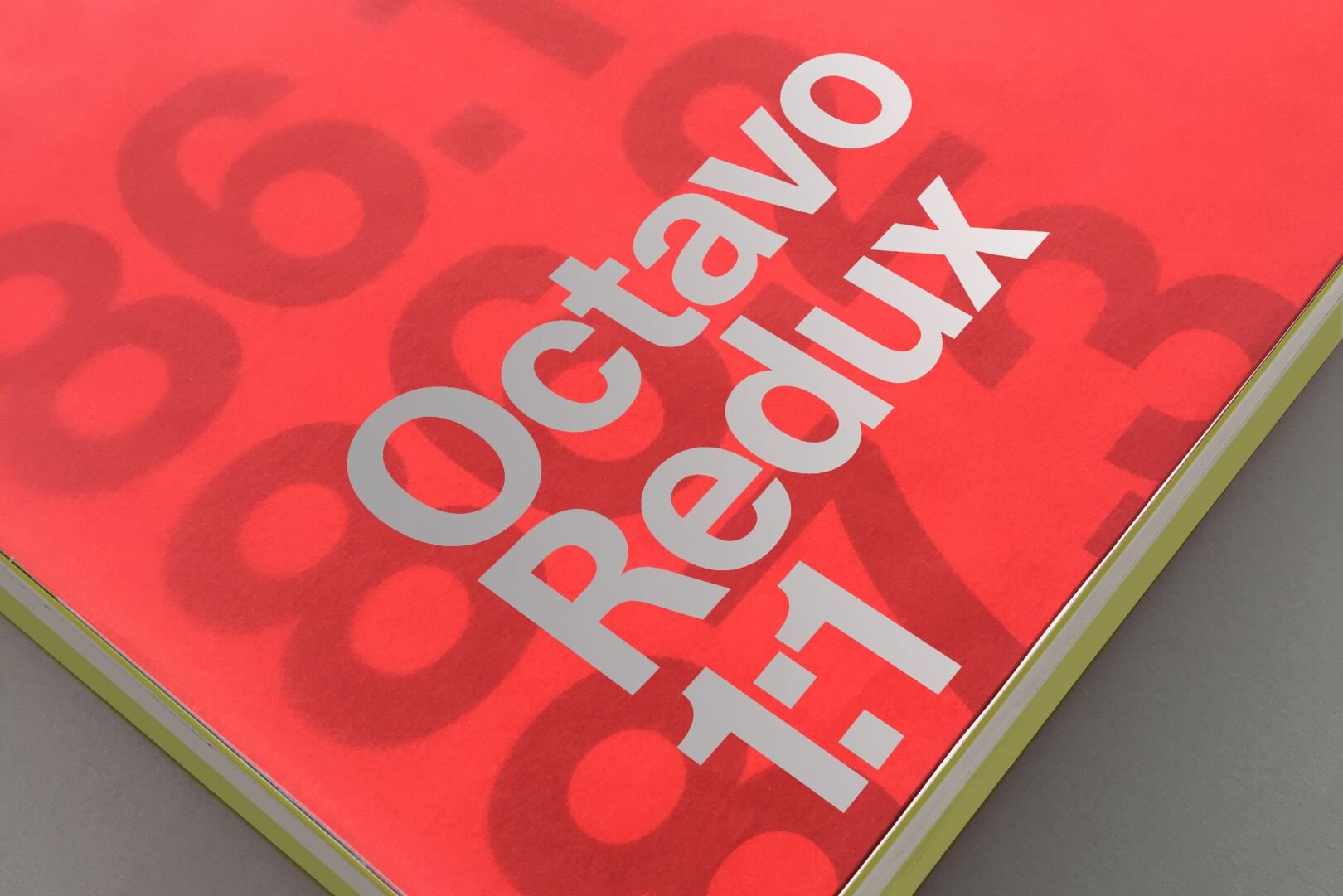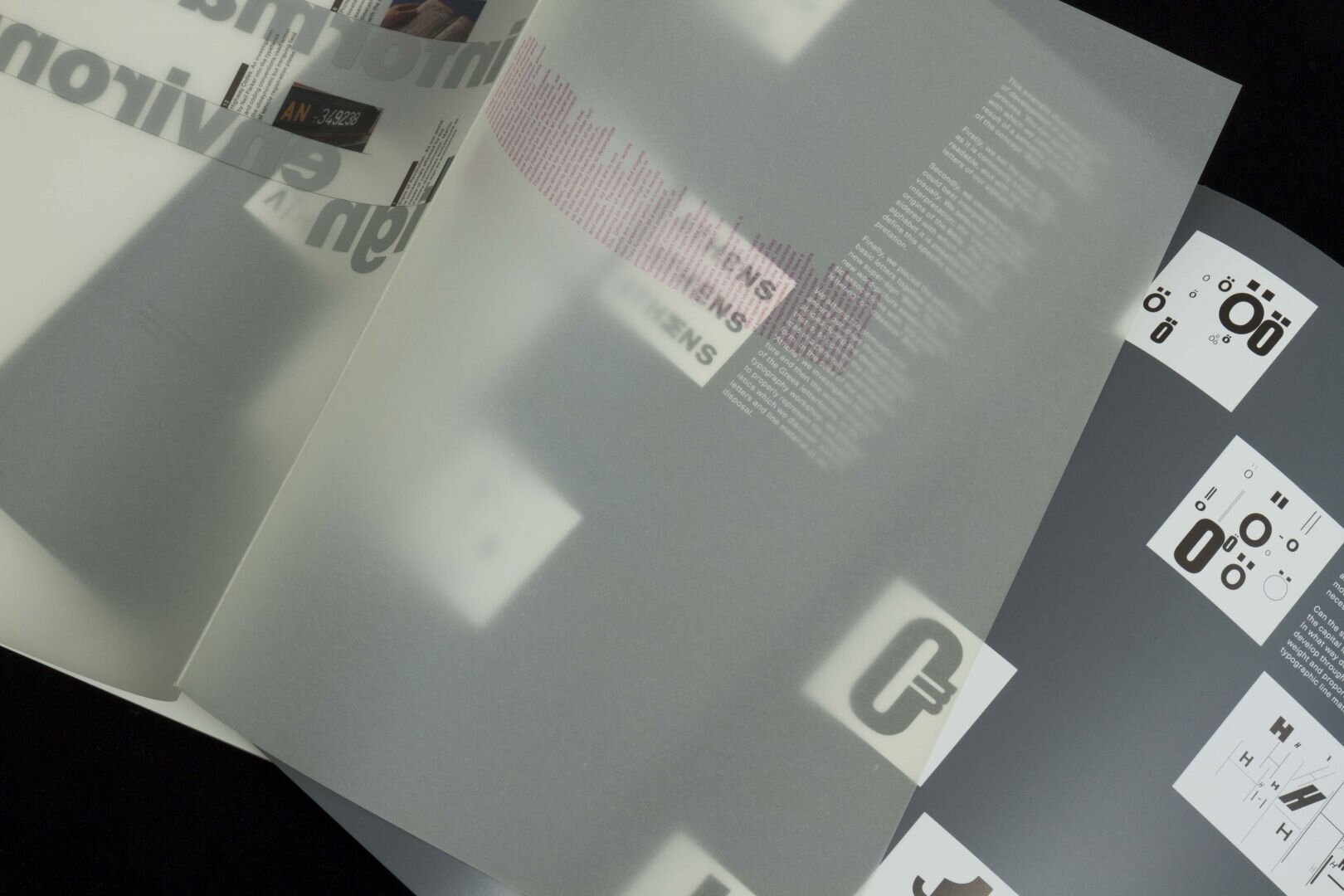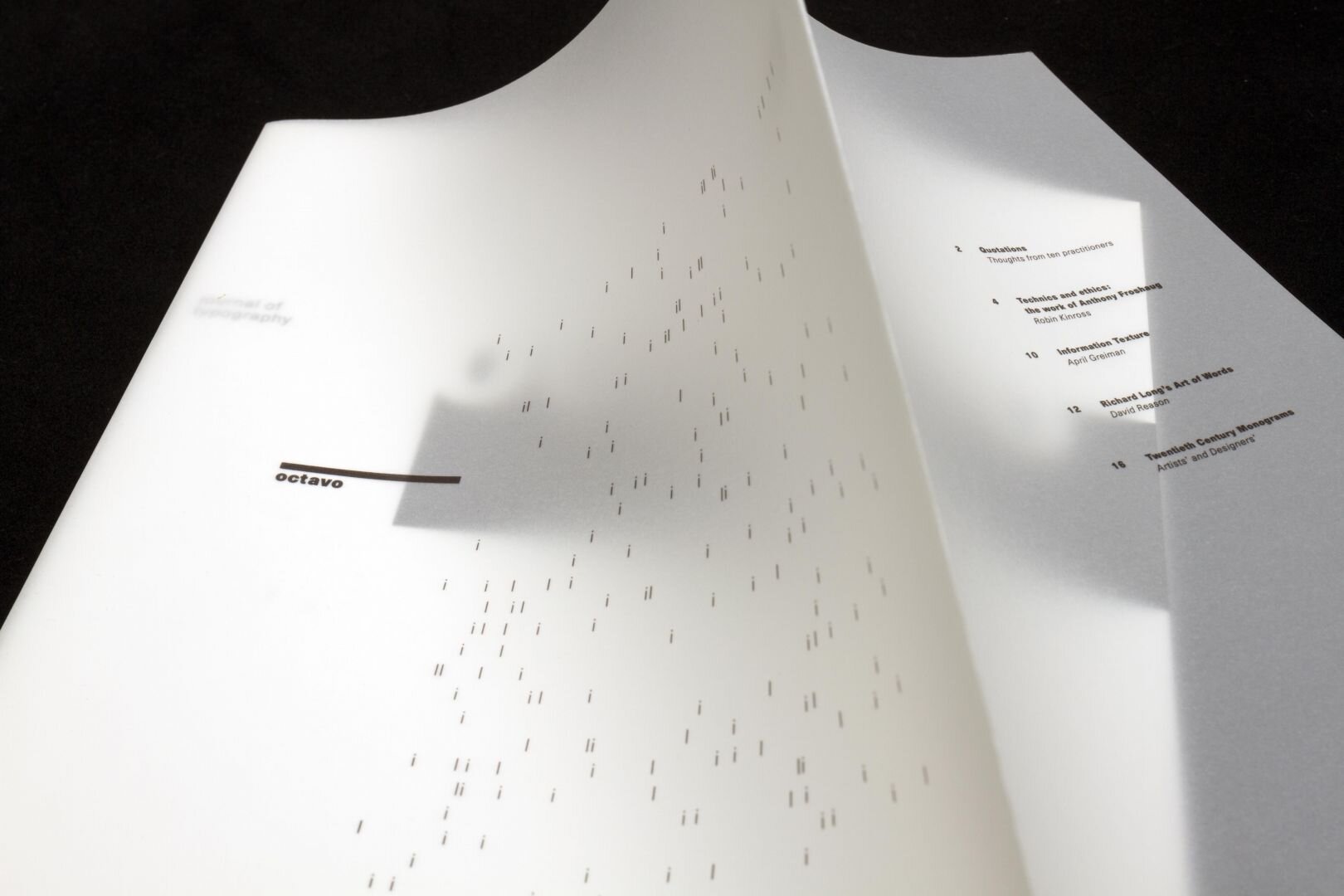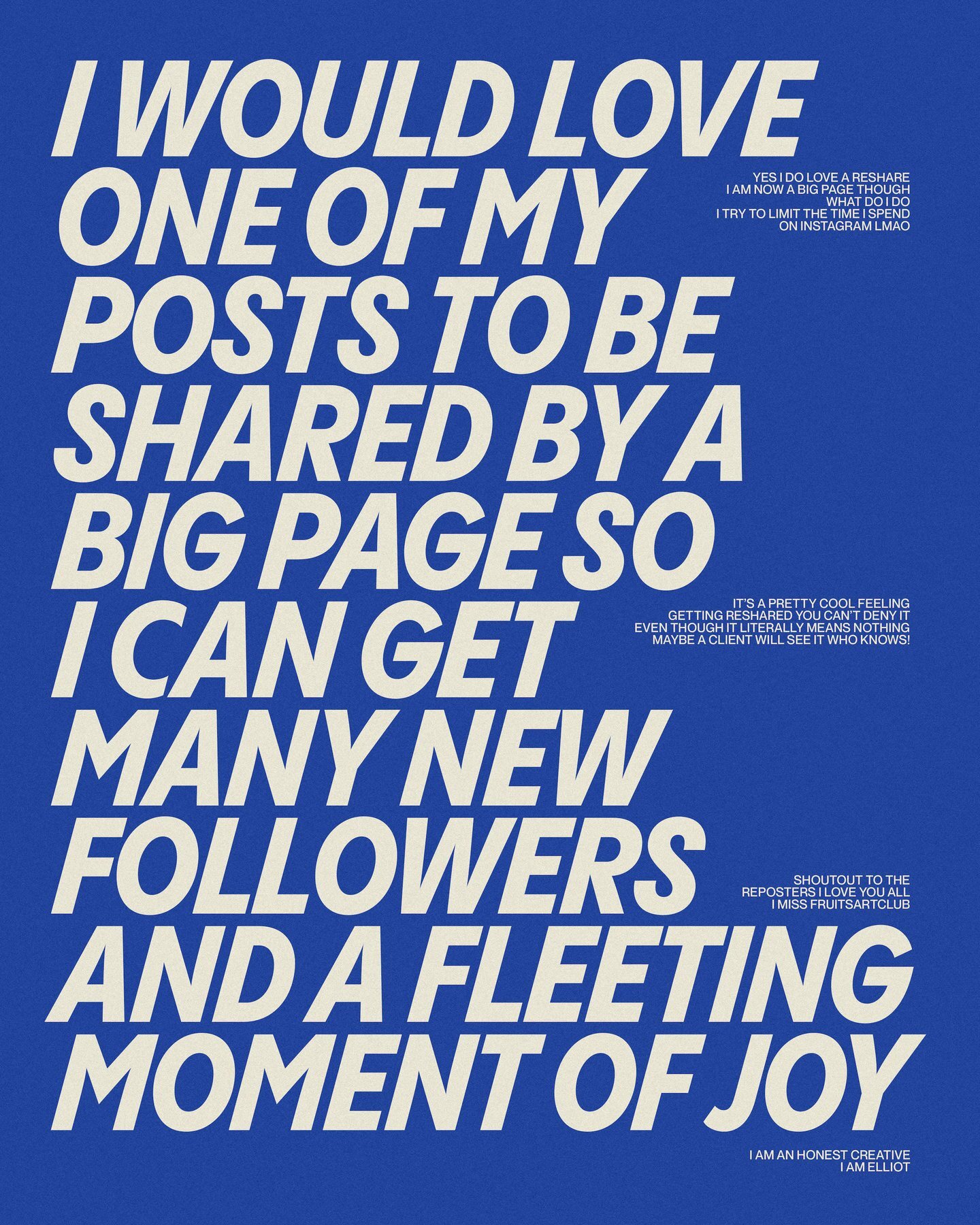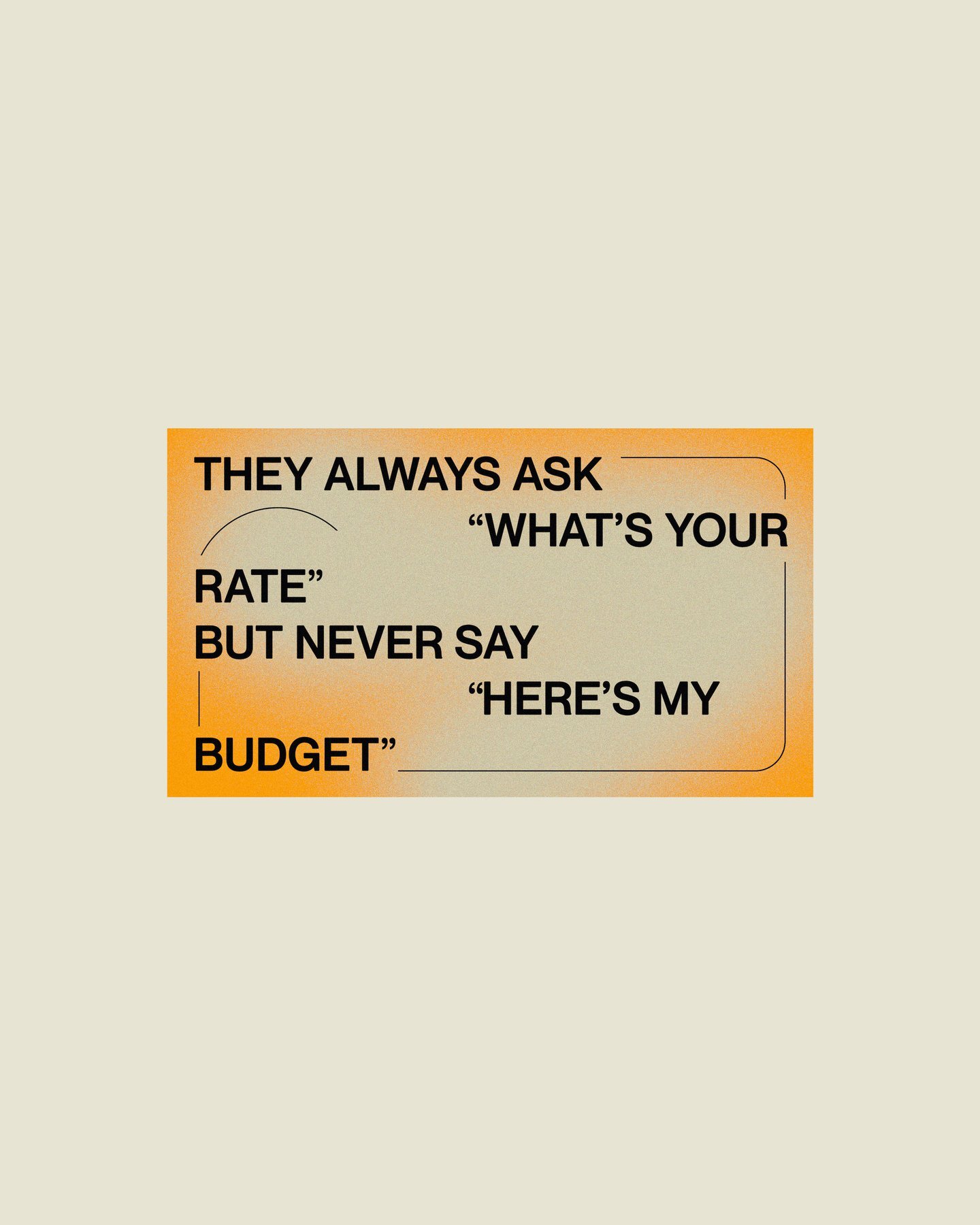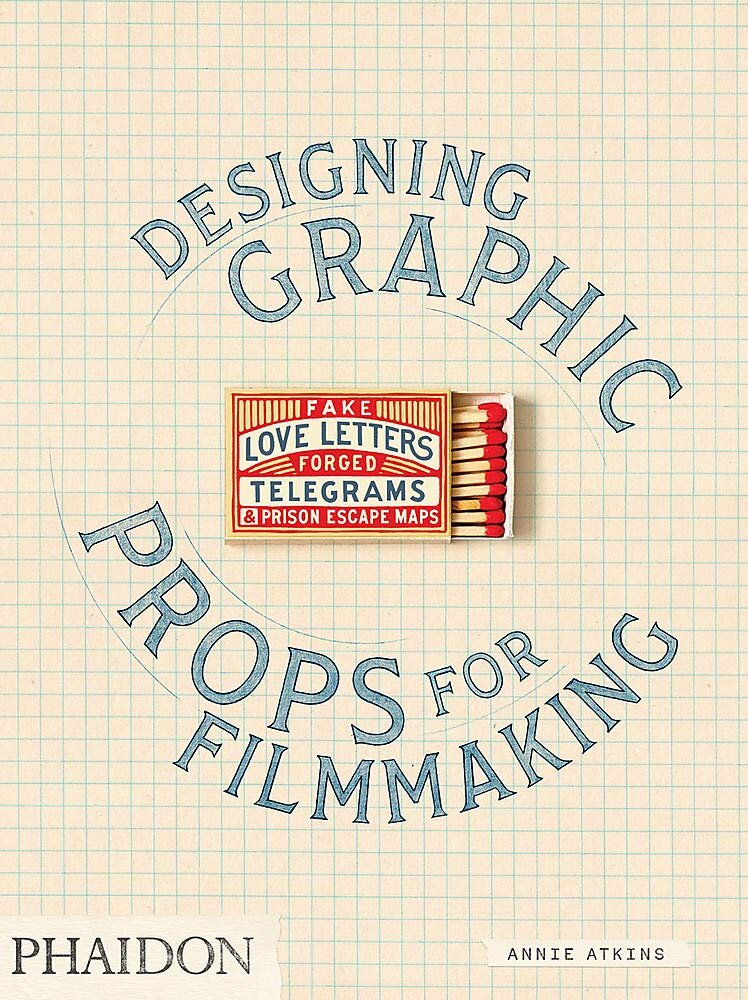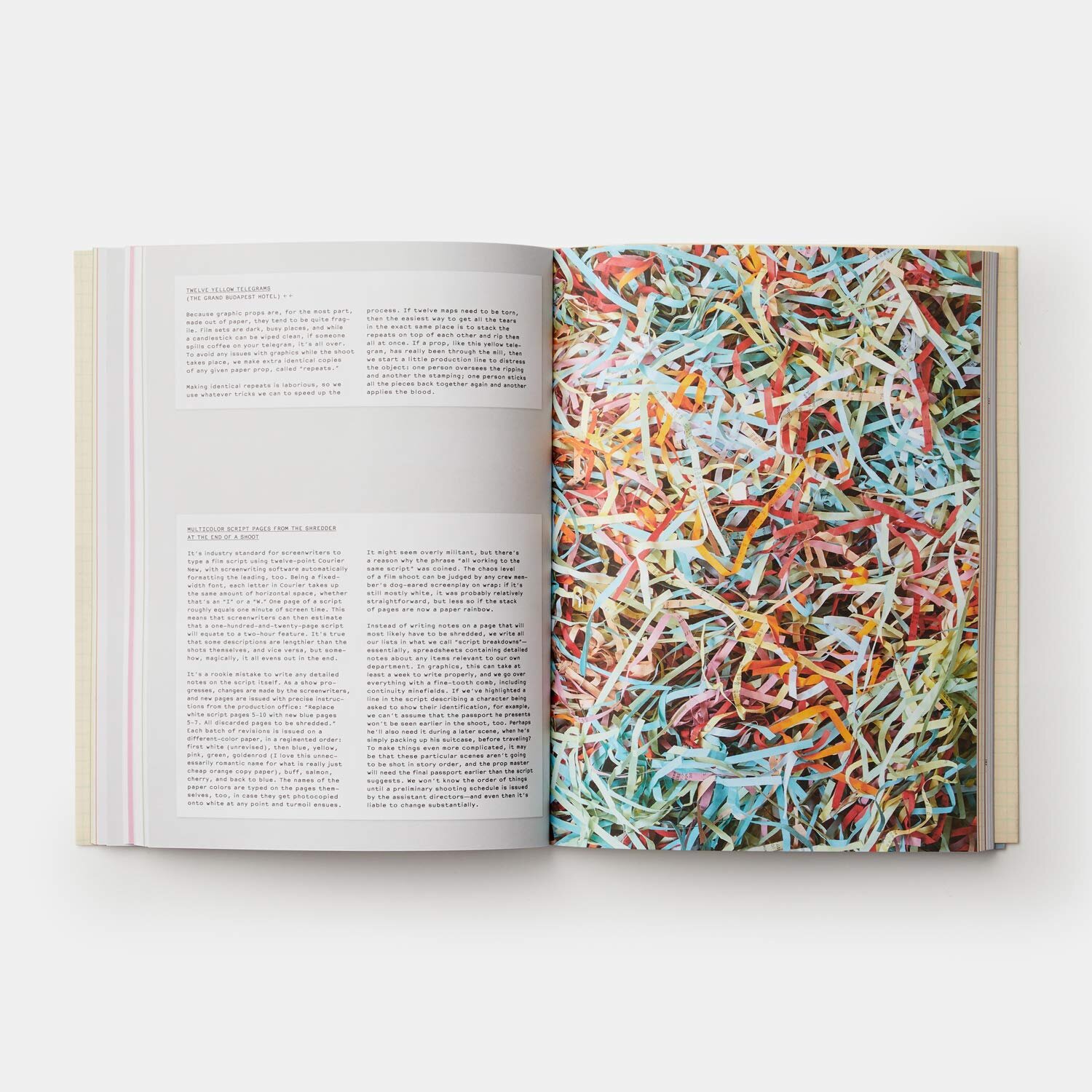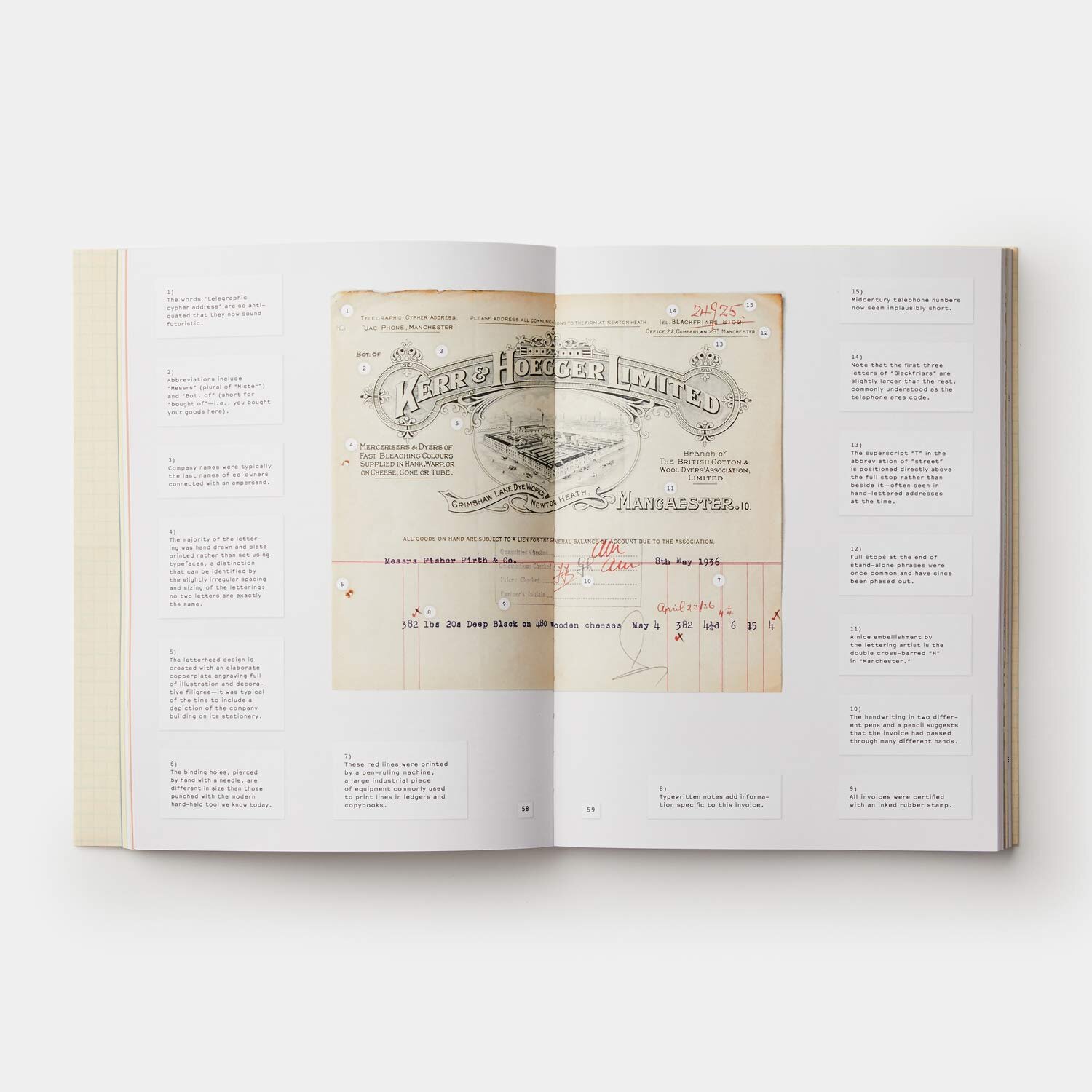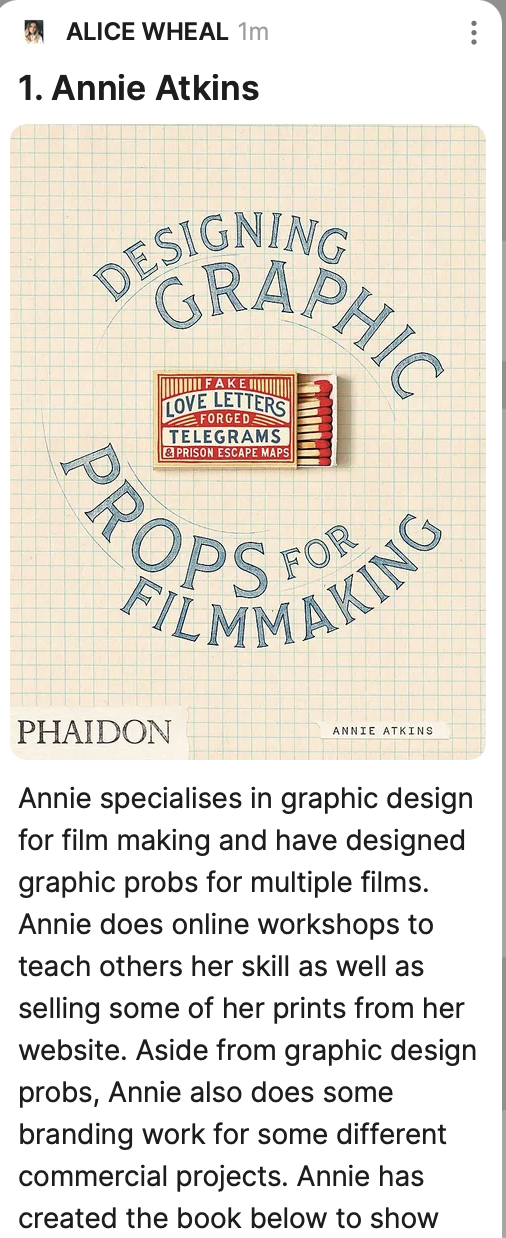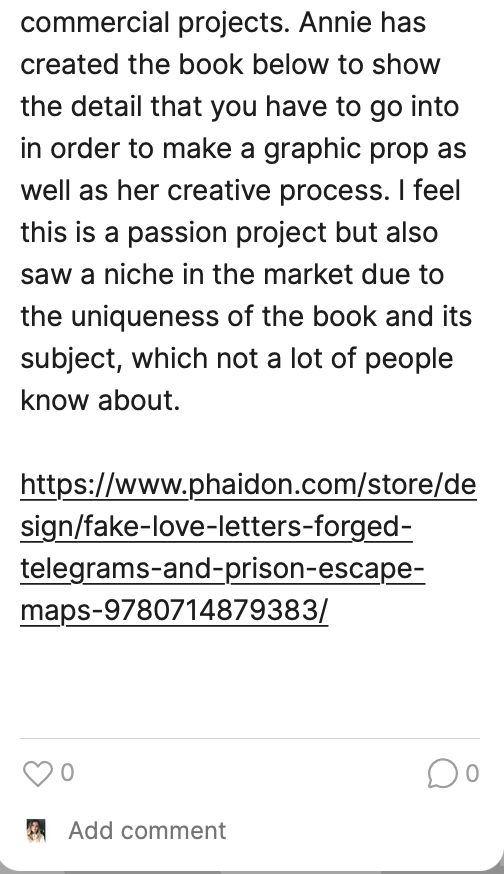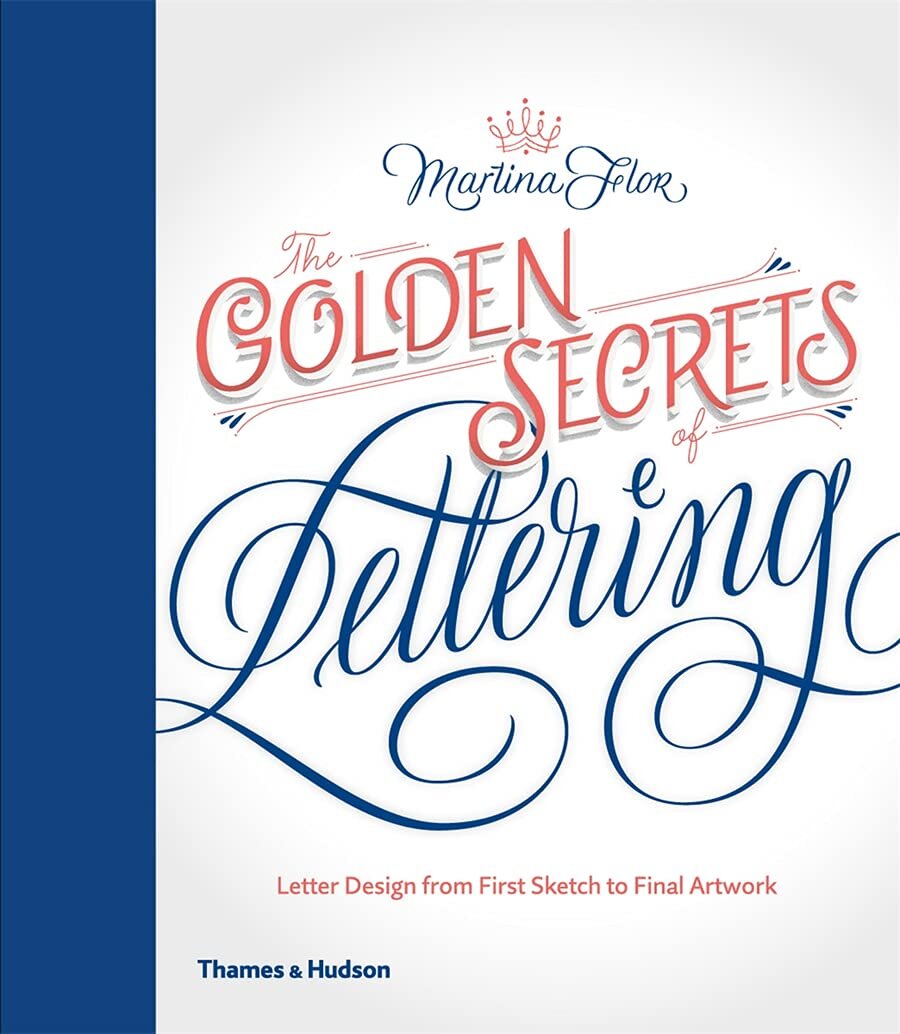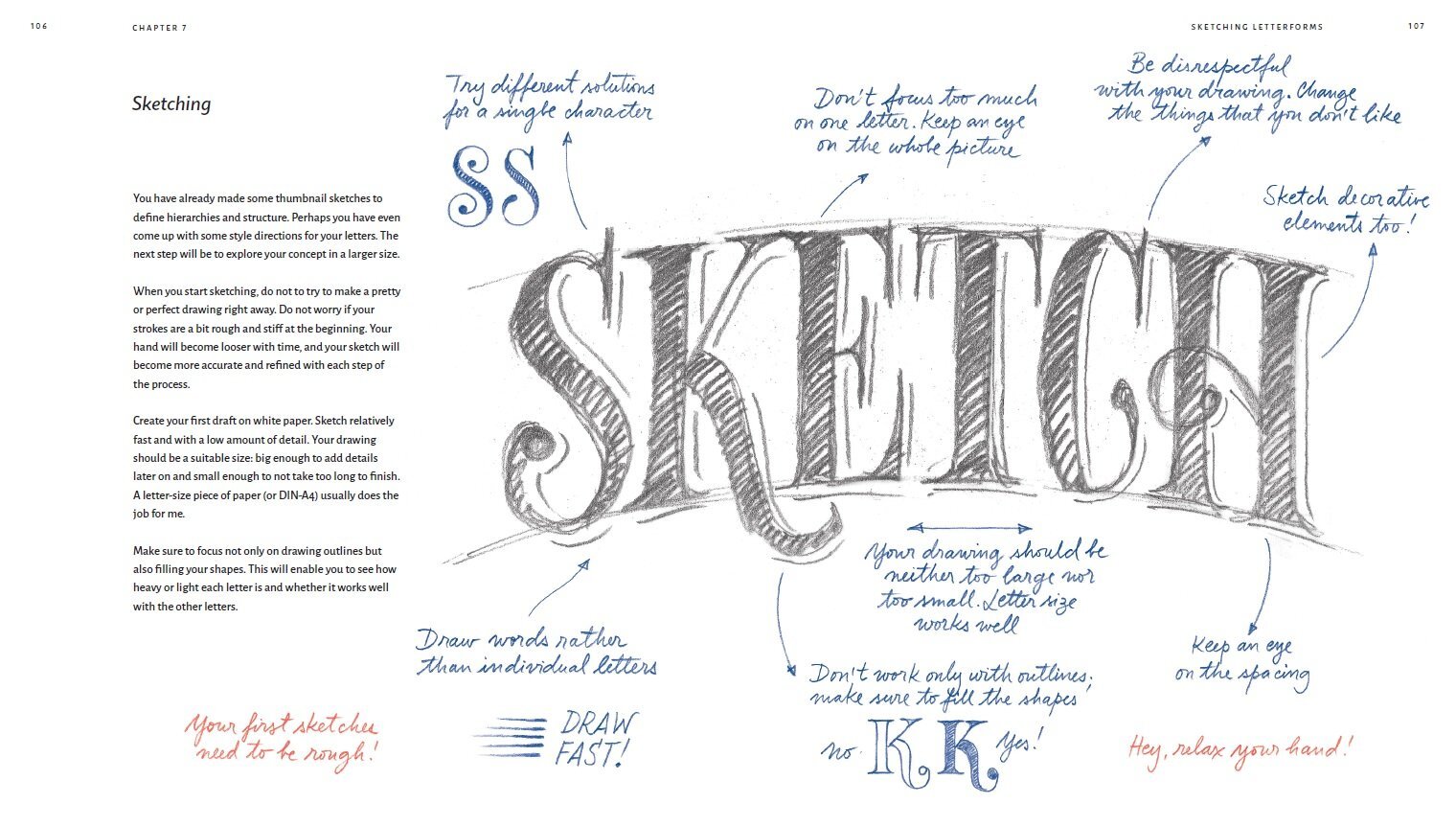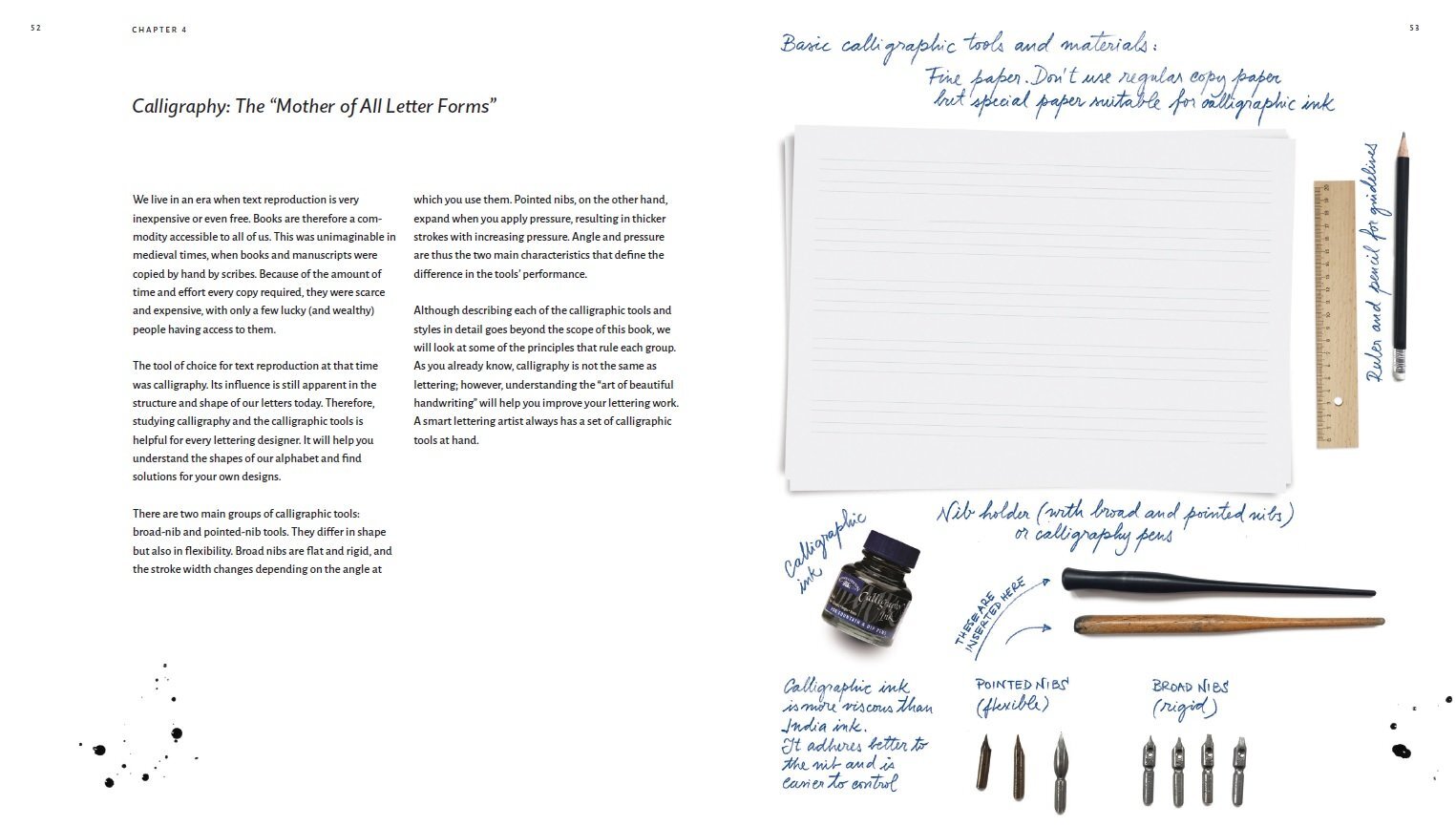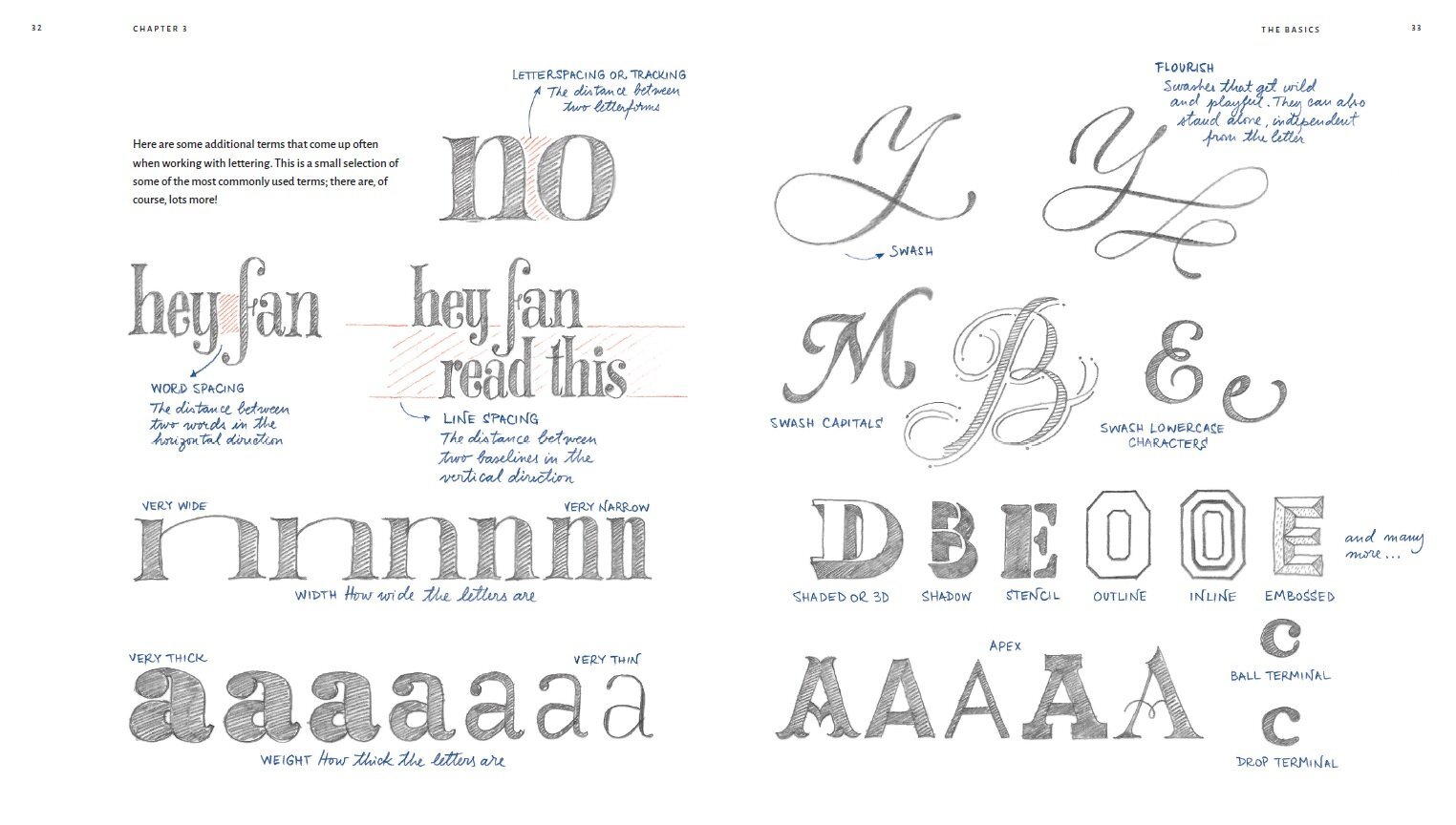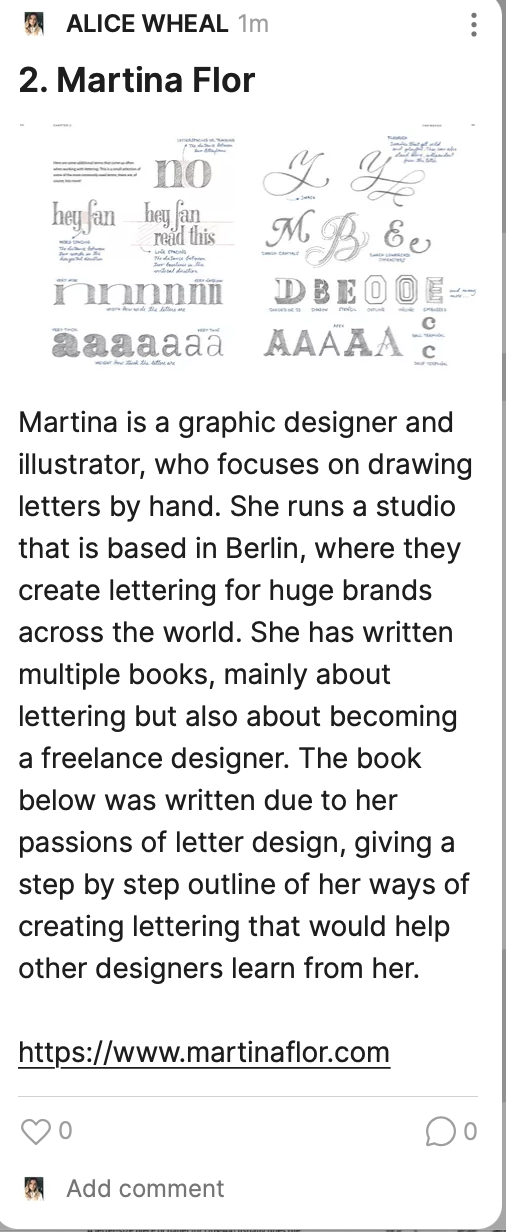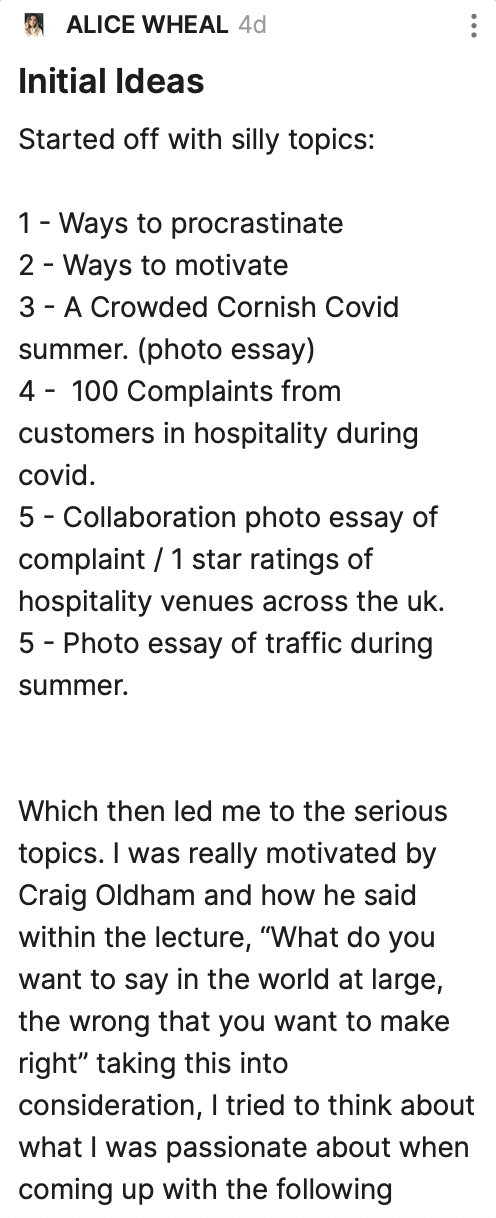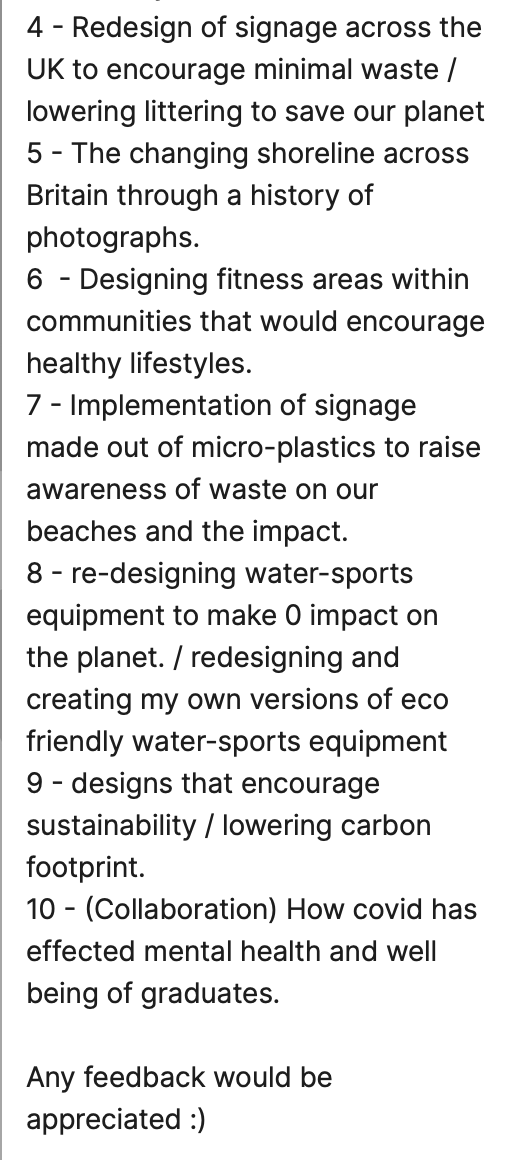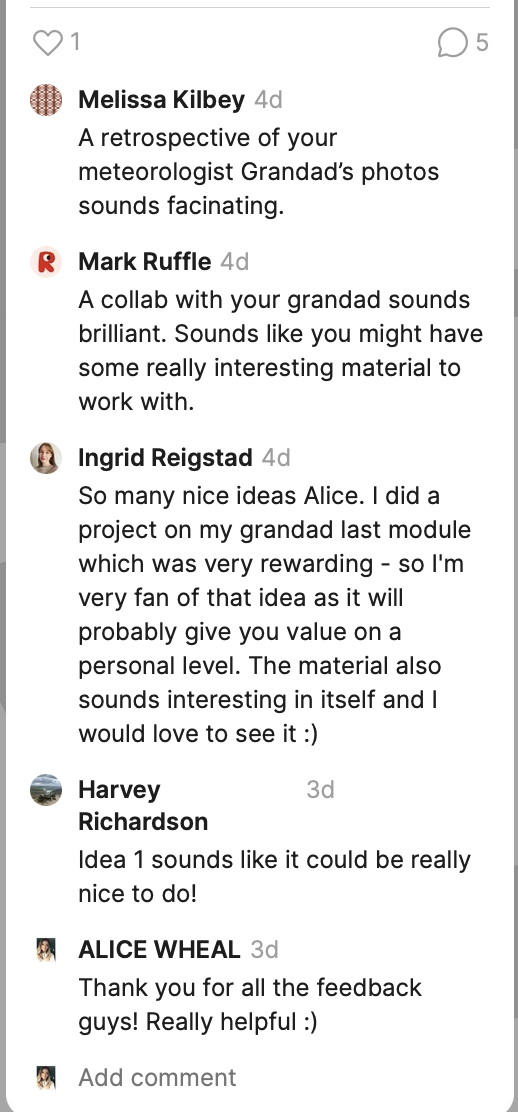Week Ten
Lecture Notes:
Lecture Reflection:
Within this lecture by Craig Oldham, he talks about his own design work and how he came to producing books. I have previously researched him and his work but only realised during this lecture that he was a design author. He talks about how we use graphic design as tools to convey messages that are important. As designers we are the problem solvers. I thought this was a really interesting approach to how authorship then comes into the picture. He also spoke about how its okay to not be a pure graphic designer and have other parts to you that you can use to your strength within authorship and self initiated projects. One of the quotes that I will be using as inspiration from this lecture is “What do you want to say in the world at large, wrong that you want to make right” . I feel this is important as a communicator, that we are here to solve problems which I am hoping will come in handy with this weeks workshop challenge.
Resources Notes:
Resources Reflection:
R1
This resource by Anthony Burill, explaining his many different projects and his journey from being a graduate to now was really interesting and re-assuring in terms of how he said he never wanted to have a job and all this time he has just done what he enjoys. I was particularly taken by the steam roller print as well as all of the work he achieves in the old fashioned way of printing with wood and metal. This is the second lecture where someone has mentioned about being a communicator and how the process is organic. Finding what we want to say as designers and coming up with own ideas amongst the rest of the visual swimming pol that we are in. I have come across Anthony Burill before but was intrigued so will research his work this week.
R2
One of the main things that i took from this article is that Daniel Eatock designed the eye for the big brother which then enabled him to kick start his career. I also thought it was interesting how he made wrapping paper out of price labels and how he talks about graphic design that it has visual power which is a strong way of putting it.
R3
I really enjoyed having a look through Kelvyn’s website and seeing the workmanship that he achieves. He has a lot of attention to detail which comes across clearly in his work. He also teaches in letter press which I would be particularly interesting in learning especially after seeing the work that he produces. He has been in films as well as selling his own prints like the ones shown below. I especially liked the ‘wear suncream’ poster which the contrast of orange and black font ad change of size / change of font which allowed impact on different places of the print.
R4
George Hardie, was an illustrator and a graphic designer for 50 years. The most interesting thing about hardie’s process is how he archives things by hand alot of the time. He feels he cant graaps the same concept on the computer. Although i was shocked to see that he spent 7 years training to be a graphic designer which seems like a long time although architecture seems to be a similar figure. Within the article he talks about how he understands lines and improving an image as-well as his tips for creating.
R5
David Kindersley and John Neilson, are both similar lettering artists that work in similar ways especially carving for architectural projects plaques and even working on many street signs that we see today.
R6
Alan Kitching, has a workshop aswell as having his own book that he calls life in a letter press which is about his life a designer and a letter press. He focuses alot on the metal and wood and texture within his work aswell as trying to be expressive which can be seen in the examples of his work below. I loved the different colours and the layering effect that he used.
R7
Ghost Box, is a record company which is infuencial with television and popular culture. They talk about how their work feeds into everything else and how Julian House was a graphic designer now turned record company. I was particularly interested in the video of the Ghost Box at an event and the multiple screens and music that they put on to create an impact on the audience.
R8
In this article by Micheal Rock, he writes about the interesting balance of being a designer as an author. How this is a new approach and can bring new approaches to design. Again he talks about how designers are ready to talk about what they believe in and rethink the process. As designers I know that we move beyond problem solving and are always craving more, so i thought this was an interesting explanation. He also mentioned some designers which i may look in too which i’ll list here; · Fabian Baron, Tibor Kalman, David Carson, Neville Brody, Edward Fella, Anthon Beeke, Pierre Bernard, Gert Dunbar, Tadanoori Yokoo, Vaughn Oliver, Rick Valincenti, April Greiman, Jan van Toorn, Wolfgang Weingart and many others.
Research:
Research, analyse and comment on the role of designer as author and as maker.
Craig Oldham
https://www.handwrittenletterproject.com/about/
I have previous researched Craig Oldham and have become a huge fan of his work since reading his book that gives advice to graduates in the real world. After hearing his lecture and feeling once again inspired, I wanted to see if he had created any more books which is when i came across the hand written letter project. The Hand written letter project, which is a collab with other designers, is about how personal a letter can be and how important it can be instead of just sending a text or email. Craig wanted designers to put their thoughts down about hand written letters and I felt this was really powerful how he’s then created a book out of their thoughts.
Anthony Burill
https://www.creativereview.co.uk/anthony-burrill-make-it-happen/
After hearing in the resources about Anthony Burill, I was really interested to now research about the book that he created. He has created many authorships as well as books. But i was particularly interested in the Make It Now, which looks at his 20 years in the design works and reflects on the work that he has created so far. Much like in the resource when he spoke about his journey through life, but this book embodied the consistant relevant body of work that he has created throughout his career. The images of the book are so clear and well put together that the story comes across. I love the way that Burill works and where he gains inspiration from.
“If you’re a communicator, you communicate through whatever means,” he concludes. “Whether that’s through a poster or an image on social media, it’s building a world. It’s building the world that you inhabit as a designer and artist.”
Self Initiated Projects
https://andwalsh.com/articles/all/creating-self-initiated-projects/
Within this article by &Walsh talks about self initiated projects that enables you to improve your creativity. They have broken the steps down of how to come up with ideas, make them happen and how to get noticed which i thought was super useful for this weeks workshop challenge.
No.1 - Coming up with ideas:
There is alot of questioning around the why! They also give advice to start a shit list of all the things that drive you mad, which is a good way of putting things. This could be where the good ideas are born.
No. 2 - What can you do about it?
Is there a way that you can tackle these problems? Can you confront these problems? Could you make an instagram account? Hone in on the ones that are feasible. Think about simplier ideas that you are able to do.
No.3 - Create a plan
Have a strict plan that will enable you to have time. Have a buddy that could keep you on track.
No.4 - Set some rules
Have a list of all the things that you need to achieve within the project. Make yourself accountable will make the time line easier.
No.5 - Develop a unique style
Have a unique style or method for your project. Think about all the different things you can design within the Book that will make you different from the rest.
No. 6 - Get your work noticed
Make a list of how you are able to get your work out there.
Why do designers write books?
https://eyeondesign.aiga.org/why-do-graphic-designers-write-books/
I previously referenced this article in another module but feel its really helpful just to recap for this weeks research. Within this article, it talks about how designers come to writing books that can be inspiring to others particularly within the graphic design field. It also talks about how often designers use the books, if it’s their passion and job, to use it as their portfolio. I am not 100% I agree with this, but i guess some designers like to show of their work within their authorship. “So if you’re a designer considering sharing your wisdom, work, and process, our advice is to make it look amazing, have something new and original to say and, again, make it look amazing— heck it’s a book for designers, after all.”
Questions of Authorship
https://www.creativereview.co.uk/questions-of-authorship/
This article by Rock Poynor, talks about how there are different terms that are used within authorship and how it can be easily misunderstood for what it actually means. It is defined within the article as being “Graphic authorship recognises the self-expressive aspect of the design process, but pushes it to a much higher level of intention. Someone writing a letter or planting flowers in a garden expresses him or herself; that doesn’t make the results literature or landscape architecture. Authorship is a more deliberate and self-conscious process. If they want to engage and enlighten others, graphic authors need – just like any author – to have pressing, original or penetrating observations to make about their experiences of the world and the conviction to express them in public. Their work needs to be about something and this cannot simply be a superficial reaction to subject matter given by a client. No one prescribes the content of a novel, a sequence of poems, or a piece of installation art. The motivation comes from an inner urge to make some form of personal statement.” He goes onto talk about how instigating own work is the only way to get full control of projects but also why shouldn’t there be a thing such as authorship if someone has something important that they want to say. This article was really helpful to understand all the different interpretations for authorship but also how it can be used.
Authorship In Digital Age
Within this article by Gem Fletcher, it talks about how we are all trying to understand authorship, especially within the digital age. It was also really useful in explaining to me that authorship is a multitude of interpretations for example it could be a credit, or name or experiences, influences and how they manifest into a creative output. The article also discusses the pro’s and cons of the digital age on authorship and how we are able to discover new designers, new space as and invite people to critic our own work but then they are all cons as well. Fletcher interviews, Daniel Castro Garcia, who talks about how authorship is the crucial part of his own practise, “I’m interested in creating work that reveals a different layer of information for the subject, based on intimacy and deeper human relationships.” As well as interviewing Lydia Pang, “I think it’s important for an artist to have a distinct point of view, but I see authorship as something different these days,” she tells me. “We’re in an open, forever shifting, sharing economy right now. Creativity is not something you own or are crowned for birthing. Gone are the days of venerated godlike artists, singular and isolated, we’re in a new time where the leaders in this space are crucially leaders of a pack, of a movement, a collective. The author is now a body of people, not an individual.” This article really opened my eyes to the possibilities that are available within authorship as well as how we can use the digital era to our advantage. “For me, originality is rooted in your authorship, original ideas are arguably born from the creative ability to use influence and imagination to create work that reveals their unique point of view.”
Book Design / Concept Examples:
Yuta Takahashi
Although not directly written by Yuta Takahashi, I feel this book design is beyond beautiful and its taken all the way through the whole book. I would love to see if Yuta did create a book what it would be about as well as the design of the whole aspect of the book.
“We designed Michael Debus' book "Erkenntnisweg und Heiliger Geist". The book attempts to use philosophy to unravel the wisdom handed down in the form of myths and legends.
To the modern person, myths are like veiled fairytales. However, the author of this book tries to use modern ways of thinking to remove the veils from these myths. As the door to forgotten knowledge appears, it's like going from darkness to daylight.
Through the unique cover art, we represented the idea of multiple layers of doors of knowledge appearing and being opened by thought. On the other side of the door, the letter "I" appears. We represented the reader's awareness transitioning from darkness to daylight through the use of neutral colors between light and shadow. As a result the book's appearance is reminiscent of the cloister in church architecture.
This book, which combines modernity and minimalism, ancient knowledge and philosophical thought, has a completely new, unique design.”
http://www.yutatakahashi.jp/work/erkenntnisweg_und_heiliger_geist/
DESIGN{H}ERS
Design[h]ers is a showcase of the emerging designers and female talent across all mediums. Although this book is a collaboration piece to celebrate women in design, I feel the whole concept and design of the book is really strong. "the here and now as an inspiring visual time capsule that captures the distinctive aesthetics and aspirations of the best in their fields, as we work towards a future where success is no longer defined by gender". I feel this would be a good book concept for this weeks workshop challenge.
Octavo Redux
Mark Holt and Hamish Muir, have come together to create a book of all the 8 editions of Octavo. Octavo was the international journal for typography, which challenged a lot of the designs in the 80s and 90s. "It sought, above everything else, to foreground typography as a solution in itself. It did this at a time when illustration was the dominant mode of graphic expression. And if all eight issues of Octavo prove anything, they prove that typography can be as expressive as image." I feel this is such a lovely concept to bring something back into something more sentimental as a book that you would be able to keep for a prolonged period of time.
Elliot Ulm
Another different approach to Authorship was this one by Elliot Ulm, who creates memes on life as a creative. Although this isn’t a whole book i feel this is really relatable messages, that are often in the form of type. If this was then taken to be book into a whole book this would be a really interesting concept. I also love the simple colour palette and the simple block type that is used.
https://www.itsnicethat.com/articles/elliot-ulm-graphic-design-250521
Workshop Challenge:
Find two examples of designers who demonstrate authorial / making expertise in the delivery of a component of their practice. Is it their sole output, are they passion projects or are they opportunities where they saw a gap in the market?
Upload onto the Ideas Wall and discuss.
Annie Atkins
https://www.amazon.com/Letters-Forged-Telegrams-Prison-Escape/dp/071487938X
Annie specialises in graphic design for film making and have designed graphic probs for multiple films. Annie does online workshops to teach others her skill as well as selling some of her prints from her website. Aside from graphic design probs, Annie also does some branding work for some different commercial projects. Annie has created the book below to show the detail that you have to go into in order to make a graphic prop as well as her creative process. I feel this is a passion project but also saw a niche in the market due to the uniqueness of the book and its subject, which not a lot of people know about.
Martina Flor
Martina is a graphic designer and illustrator, who focuses on drawing letters by hand. She runs a studio that is based in Berlin, where they create lettering for huge brands across the world. She has written multiple books, mainly about lettering but also about becoming a freelance designer. The book below was written due to her passions of letter design, giving a step by step outline of her ways of creating lettering that would help other designers learn from her.
Think about a series of outputs you could make as an author.
Generate 10 ideas for discussion, upload to the Ideas Wall and elaborate further on the blog. Please note, this is the first step of you considering one idea that will be researched and potentially launched as an authorised artefact through the last part of this module.
To start of the ideas for this weeks challenge, I started by taking inspiration from &Walsh and listed all the things that i find annoying and then tried to see if i could change them into an idea:
1 - ways to procastinate
2 - ways to motivate
3 - A Crowded Cornish Covid summer. (photo essay)
4 - 100 Complaints from customers in hospitality during covid.
5 - photo essay of traffic during summer.
I then went on to do a mindmap of ideas and things that i was passionate about:
This then led me to the final ideas:
1 - The changing world - A collaboration with my granddad who used to travel the world taking pictures as-well as being a meteorologist. He always has an interesting perspective on global warming as-well as taking stunning pictures. I feel this could potentially show people how climate change is happening in front of us.
2 - Graphic design combined with Interior Design / Architecture - Images of how graphic design is combined within spaces and how it can improve mental health. (Week 6 interview)
3 - Design for the changing planet - If our planet is changing to climate change, how we can adapt our homes and every day lives to make sure we are ready for every eventuality.
4 - Redesign of signage across the UK to encourage minimal waste / lowering littering to save our planet
5 - The changing shoreline across Britain through a history of photographs.
6 - Designing fitness ares within communities that would encourage healthy lifestyles.
7 - Implementation of signage made out of micro-plastics to raise awareness of waste on our beaches and the impact.
8 - re-designing water-sports equipment to make 0 impact on the planet. / redesigning and creating my own versions of eco friendly water-sports equipment
9 - designs that encourage sustainability / lowering carbon footprint.
10 - How covid has effected mental health and well being of graduates in current climate.
Weekly Reflection:
This week was really motivating for me to see what was available int he world of book design and how authorship really came about. I was particularly inspired by Burill and Oldham and the words that they spoke within both their lectures about their design journeys and how they got to where they are. I tried to take this inspiration as well as &Walsh tips on coming up with ideas to put that into this weeks workshop challenge. I tried to think about words that wouldn’t necessarily be profitable but would maybe be inspiring and interesting for others.
